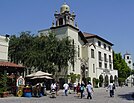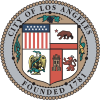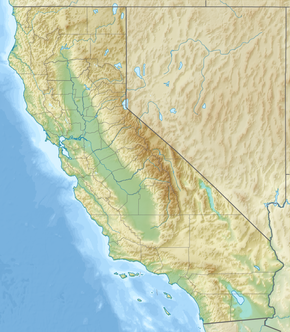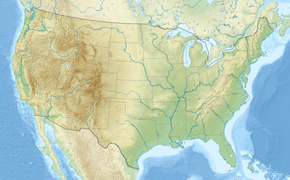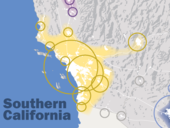Los Angeles
Los Angeles | |
|---|---|
| City of Los Angeles | |
| Nicknames: | |
 Location within Los Angeles County | |
| Coordinates: 34°03′N 118°15′W / 34.050°N 118.250°W | |
| Country | United States |
| State | California |
| County | Los Angeles |
| Region | Southern California |
| CSA | Los Angeles-Long Beach |
| MSA | Los Angeles-Long Beach-Anaheim |
| Pueblo | September 4, 1781[2] |
| City status | May 23, 1835[3] |
| Incorporated | April 4, 1850[4] |
| Named for | Our Lady, Queen of the Angels |
| Government | |
| • Type | Strong mayor–council[5] |
| • Body | Los Angeles City Council |
| • Mayor | Karen Bass (D) |
| • City Attorney | Hydee Feldstein Soto (D) |
| • City Controller | Kenneth Mejia (D) |
| Area | |
| • Total | 501.55 sq mi (1,299.01 km2) |
| • Land | 469.49 sq mi (1,215.97 km2) |
| • Water | 32.06 sq mi (83.04 km2) |
| Elevation | 305 ft (93 m) |
| Highest elevation | 5,075 ft (1,576 m) |
| Lowest elevation | 0 ft (0 m) |
| Population | |
| • Total | 3,898,747 |
| • Estimate (2022)[7] | 3,819,538 |
| • Rank | 3rd in North America 2nd in the United States 1st in California |
| • Density | 8,304.22/sq mi (3,206.29/km2) |
| • Urban | 12,237,376 (US: 2nd) |
| • Urban density | 7,476.3/sq mi (2,886.6/km2) |
| • Metro | 13,200,998 (US: 2nd) |
| Demonyms | Angeleno, Angelino, Angeleño[10][11] |
| GDP | |
| • MSA | $1.227 trillion (2022) |
| • CSA | $1.528 trillion (2022) |
| Time zone | UTC–08:00 (PST) |
| • Summer (DST) | UTC–07:00 (PDT) |
| ZIP Codes | List |
| Area codes | 213, 323, 310, 424, 818, 747, 626 |
| FIPS code | 06-44000 |
| GNIS feature IDs | 1662328, 2410877 |
| Website | lacity |
Los Angeles,[a] often referred to by its initials L.A., is the most populous city in the U.S. state of California. With roughly 3.9 million residents within the city limits as of 2020[update],[7] Los Angeles is the second-most populous city in the United States, behind only New York City; it is also the commercial, financial and cultural center of Southern California. Los Angeles has an ethnically and culturally diverse population, and is the principal city of a metropolitan area of 13.2 million people. Greater Los Angeles, which includes the Los Angeles and Riverside–San Bernardino metropolitan areas, is a sprawling metropolis of over 18 million residents.
The majority of the city proper lies in a basin in Southern California adjacent to the Pacific Ocean in the west and extending partly through the Santa Monica Mountains and north into the San Fernando Valley, with the city bordering the San Gabriel Valley to its east. It covers about 469 square miles (1,210 km2),[6] and is the county seat of Los Angeles County, which is the most populous county in the United States with an estimated 9.86 million residents as of 2022[update].[16] It is the fourth-most visited city in the U.S. with over 2.7 million visitors as of 2022.[17]
The area that became Los Angeles was originally inhabited by the indigenous Tongva people and later claimed by Juan Rodríguez Cabrillo for Spain in 1542. The city was founded on September 4, 1781, under Spanish governor Felipe de Neve, on the village of Yaanga.[18] It became a part of Mexico in 1821 following the Mexican War of Independence. In 1848, at the end of the Mexican–American War, Los Angeles and the rest of California were purchased as part of the Treaty of Guadalupe Hidalgo and became part of the United States. Los Angeles was incorporated as a municipality on April 4, 1850, five months before California achieved statehood. The discovery of oil in the 1890s brought rapid growth to the city.[19] The city was further expanded with the completion of the Los Angeles Aqueduct in 1913, which delivers water from Eastern California.
Los Angeles has a diverse economy with a broad range of industries. Despite a steep decline in film and television production since the Covid-19 pandemic, Los Angeles is now still the third-largest node of American film production,[20][21] the world’s largest by revenue; the city was an important site in the history of film. It also has one of the busiest container ports in the Americas.[22][23][24] In 2018, the Los Angeles metropolitan area had a gross metropolitan product of over $1.0 trillion,[25] making it the city with the third-largest GDP in the world, after New York and Tokyo. Los Angeles hosted the Summer Olympics in 1932 and 1984, and will also host in 2028. Despite a business exodus from Downtown Los Angeles since the COVID-19 pandemic, the city's urban core is evolving as a cultural center with the world's largest showcase of architecture designed by Frank Gehry.[26]
Toponymy
On September 4, 1781, a group of 44 settlers known as "Los Pobladores" founded the pueblo (town) they called El Pueblo de Nuestra Señora la Reina de los Ángeles, 'The Town of Our Lady the Queen of the Angels'.[27] The original name of the settlement is disputed; the Guinness Book of World Records rendered it as "El Pueblo de Nuestra Señora la Reina de los Ángeles de Porciúncula";[28] other sources have shortened or alternate versions of the longer name.[29]
The local English pronunciation of the name of the city has varied over time. A 1953 article in the journal of the American Name Society asserts that the pronunciation /lɔːs ˈændʒələs/ lawss AN-jəl-əs was established following the 1850 incorporation of the city and that since the 1880s the pronunciation /loʊs ˈæŋɡələs/ lohss ANG-gəl-əs emerged from a trend in California to give places Spanish, or Spanish-sounding, names and pronunciations.[30] In 1908, librarian Charles Fletcher Lummis, who argued for the name's pronunciation with a hard g (/ɡ/),[31][32] reported that there were at least 12 pronunciation variants.[33] In the early 1900s, the Los Angeles Times advocated for pronouncing it Loce AHNG-hayl-ais (/loʊs ˈɑːŋheɪleɪs/), approximating Spanish [los ˈaŋxeles], by printing the respelling under its masthead for several years.[34] This did not find favor.[35]
Since the 1930s, /lɔːs ˈændʒələs/ has been most common.[36] In 1934, the United States Board on Geographic Names decreed that this pronunciation be used by the federal government.[34] This was also endorsed in 1952 by a "jury" appointed by Mayor Fletcher Bowron to devise an official pronunciation.[30][34]
Common pronunciations in the United Kingdom include /lɒs ˈændʒɪliːz, -lɪz, -lɪs/ loss AN-jil-eez, -iz, -iss.[37] Phonetician Jack Windsor Lewis described the most common one, /lɒs ˈændʒɪliːz/ , as a spelling pronunciation based on analogy to Greek words ending in -es, "reflecting a time when the classics were familiar if Spanish was not".[38]
History
Indigenous history

The settlement of Indigenous Californians in the modern Los Angeles Basin and the San Fernando Valley was dominated by the Tongva (now also known as the Gabrieleño since the era of Spanish colonization). The historic center of Tongva power in the region was the settlement of Yaanga (Tongva: Iyáangẚ), meaning "place of the poison oak", which would one day be the site where the Spanish founded the Pueblo de Los Ángeles. Iyáangẚ has also been translated as "the valley of smoke".[39][40][41][42][18]
Spanish rule
Maritime explorer Juan Rodríguez Cabrillo claimed the area of southern California for the Spanish Empire in 1542, while on an official military exploring expedition, as he was moving northward along the Pacific coast from earlier colonizing bases of New Spain in Central and South America.[43] Gaspar de Portolà and Franciscan missionary Juan Crespí reached the present site of Los Angeles on August 2, 1769.[44]
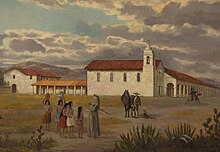
In 1771, Franciscan friar Junípero Serra directed the building of the Mission San Gabriel Arcángel, the first mission in the area.[45] On September 4, 1781, a group of 44 settlers known as "Los Pobladores" founded the pueblo (town) they called El Pueblo de Nuestra Señora la Reina de los Ángeles, 'The Town of Our Lady the Queen of the Angels'.[27] The present-day city has the largest Roman Catholic archdiocese in the United States. Two-thirds of the Mexican or (New Spain) settlers were mestizo or mulatto, a mixture of African, indigenous and European ancestry.[46] The settlement remained a small ranch town for decades, but by 1820, the population had increased to about 650 residents.[47] Today, the pueblo is commemorated in the historic district of Los Angeles Pueblo Plaza and Olvera Street, the oldest part of Los Angeles.[48]
Mexican rule

New Spain achieved its independence from the Spanish Empire in 1821, and the pueblo now existed within the new Mexican Republic. During Mexican rule, Governor Pío Pico made Los Angeles the regional capital of Alta California.[49] By this time, the new republic introduced more secularization acts within the Los Angeles region.[50] In 1846, during the wider Mexican-American war, marines from the United States occupied the pueblo. This resulted in the siege of Los Angeles where 150 Mexican militias fought the occupiers which eventually surrendered.[51]
Mexican rule ended during following the American Conquest of California, part of the larger Mexican-American War. Americans took control from the Californios after a series of battles, culminating with the signing of the Treaty of Cahuenga on January 13, 1847.[52] The Mexican Cession was formalized in the Treaty of Guadalupe Hidalgo in 1848, which ceded Los Angeles and the rest of Alta California to the United States.
Post-Conquest era

Railroads arrived with the completion of the transcontinental Southern Pacific line from New Orleans to Los Angeles in 1876 and the Santa Fe Railroad in 1885.[53] Petroleum was discovered in the city and surrounding area in 1892, and by 1923, the discoveries had helped California become the country's largest oil producer, accounting for about one-quarter of the world's petroleum output.[54]
By 1900, the population had grown to more than 102,000,[55] putting pressure on the city's water supply.[56] The completion of the Los Angeles Aqueduct in 1913, under the supervision of William Mulholland, ensured the continued growth of the city.[57] Because of clauses in the city's charter that prevented the City of Los Angeles from selling or providing water from the aqueduct to any area outside its borders, many adjacent cities and communities felt compelled to join Los Angeles.[58][59][60]
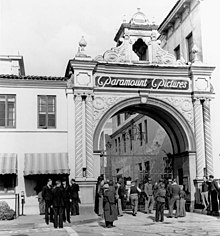
Los Angeles created the first municipal zoning ordinance in the United States. On September 14, 1908, the Los Angeles City Council promulgated residential and industrial land use zones. The new ordinance established three residential zones of a single type, where industrial uses were prohibited. The proscriptions included barns, lumber yards, and any industrial land use employing machine-powered equipment. These laws were enforced against industrial properties after the fact. These prohibitions were in addition to existing activities that were already regulated as nuisances. These included explosives warehousing, gas works, oil drilling, slaughterhouses, and tanneries. Los Angeles City Council also designated seven industrial zones within the city. However, between 1908 and 1915, the Los Angeles City Council created various exceptions to the broad proscriptions that applied to these three residential zones, and as a consequence, some industrial uses emerged within them. There are two differences between the 1908 Residence District Ordinance and later zoning laws in the United States. First, the 1908 laws did not establish a comprehensive zoning map as the 1916 New York City Zoning Ordinance did. Second, the residential zones did not distinguish types of housing; they treated apartments, hotels, and detached-single-family housing equally.[61]
In 1910, Hollywood merged into Los Angeles, with 10 movie companies already operating in the city at the time. By 1921, more than 80 percent of the world's film industry was concentrated in L.A.[62] The money generated by the industry kept the city insulated from much of the economic loss suffered by the rest of the country during the Great Depression.[63]By 1930, the population surpassed one million.[64] In 1932, the city hosted the Summer Olympics.
Post-WWII
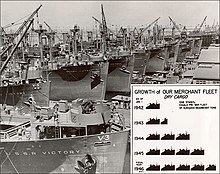
During World War II Los Angeles was a major center of wartime manufacturing, such as shipbuilding and aircraft. Calship built hundreds of Liberty Ships and Victory Ships on Terminal Island, and the Los Angeles area was the headquarters of six of the country's major aircraft manufacturers (Douglas Aircraft Company, Hughes Aircraft, Lockheed, North American Aviation, Northrop Corporation, and Vultee). During the war, more aircraft were produced in one year than in all the pre-war years since the Wright brothers flew the first airplane in 1903, combined. Manufacturing in Los Angeles skyrocketed, and as William S. Knudsen, of the National Defense Advisory Commission put it, "We won because we smothered the enemy in an avalanche of production, the like of which he had never seen, nor dreamed possible."[65]
After the end of World War II Los Angeles grew more rapidly than ever, sprawling into the San Fernando Valley.[66] The expansion of the state owned Interstate Highway System during the 1950s and 1960s helped propel suburban growth and signaled the demise of the city's privately owned electrified rail system, once the world's largest.
As a consequence of World War II, suburban growth, and population density, many amusement parks were built and operated in this area.[67] An example is Beverly Park, which was located at the corner of Beverly Boulevard and La Cienega before being closed and substituted by the Beverly Center.[68]
In the second half of the 20th century, Los Angeles substantially reduced the amount of housing that could be built by drastically downzoning the city. In 1960, the city had a total zoned capacity for approximately 10 million people. By 1990, that capacity had fallen to 4.5 million as a result of policy decisions to ban housing through zoning.[69]
Racial tensions led to the Watts riots in 1965, resulting in 34 deaths and over 1,000 injuries.[70]
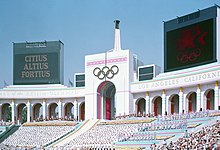
In 1969, California became the birthplace of the Internet, as the first ARPANET transmission was sent from the University of California, Los Angeles (UCLA) to the Stanford Research Institute in Menlo Park.[71]
In 1973, Tom Bradley was elected as the city's first African American mayor, serving for five terms until retiring in 1993. Other events in the city during the 1970s included the Symbionese Liberation Army's South Central standoff in 1974 and the Hillside Stranglers murder cases in 1977–1978.[72]
In early 1984, the city surpassed Chicago in population, thus becoming the second largest city in the United States.
In 1984, the city hosted the Summer Olympic Games for the second time. Despite being boycotted by 14 Communist countries, the 1984 Olympics became more financially successful than any previous,[73] and the second Olympics to turn a profit; the other, according to an analysis of contemporary newspaper reports, was the 1932 Summer Olympics, also held in Los Angeles.[74]
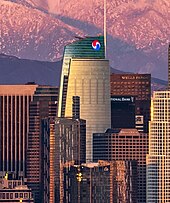
Racial tensions erupted on April 29, 1992, with the acquittal by a Simi Valley jury of four Los Angeles Police Department (LAPD) officers captured on videotape beating Rodney King, culminating in large-scale riots.[75][76]
In 1994, the magnitude 6.7 Northridge earthquake shook the city, causing $12.5 billion in damage and 72 deaths.[77] The century ended with the Rampart scandal, one of the most extensive documented cases of police misconduct in American history.[78]
21st century
In 2002, Mayor James Hahn led the campaign against secession, resulting in voters defeating efforts by the San Fernando Valley and Hollywood to secede from the city.[79]
In 2022, Karen Bass became the city's first female mayor, making Los Angeles the largest U.S. city to have ever had a woman as mayor.[80]
Los Angeles will host the 2028 Summer Olympics and Paralympic Games, making Los Angeles the third city to host the Olympics three times.[81][82]
Geography
Topography

The city of Los Angeles covers a total area of 502.7 square miles (1,302 km2), comprising 468.7 square miles (1,214 km2) of land and 34.0 square miles (88 km2) of water.[83] The city extends for 44 miles (71 km) from north to south and for 29 miles (47 km) from east to west. The perimeter of the city is 342 miles (550 km).
Los Angeles is both flat and hilly. The highest point in the city proper is Mount Lukens at 5,074 ft (1,547 m),[84][85] located in the foothills of the San Gabriel Mountains at the north extent of the Crescenta Valley. The eastern end of the Santa Monica Mountains stretches from Downtown to the Pacific Ocean and separates the Los Angeles Basin from the San Fernando Valley. Other hilly parts of Los Angeles include the Mt. Washington area north of Downtown, eastern parts such as Boyle Heights, the Crenshaw district around the Baldwin Hills, and the San Pedro district.
Surrounding the city are much higher mountains. Immediately to the north lie the San Gabriel Mountains, which is a popular recreation area for Angelenos. Its high point is Mount San Antonio, locally known as Mount Baldy, which reaches 10,064 feet (3,068 m). Further afield, the highest point in southern California is San Gorgonio Mountain, 81 miles (130 km) east of downtown Los Angeles,[86] with a height of 11,503 feet (3,506 m).
The Los Angeles River, which is largely seasonal, is the primary drainage channel. It was straightened and lined in 51 miles (82 km) of concrete by the Army Corps of Engineers to act as a flood control channel.[87] The river begins in the Canoga Park district of the city, flows east from the San Fernando Valley along the north edge of the Santa Monica Mountains, and turns south through the city center, flowing to its mouth in the Port of Long Beach at the Pacific Ocean. The smaller Ballona Creek flows into the Santa Monica Bay at Playa del Rey.
Vegetation
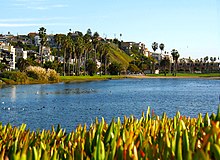
Los Angeles is rich in native plant species partly because of its diversity of habitats, including beaches, wetlands, and mountains. The most prevalent plant communities are coastal sage scrub, chaparral shrubland, and riparian woodland.[88] Native plants include: the California poppy, matilija poppy, toyon, Ceanothus, Chamise, Coast Live Oak, sycamore, willow and Giant Wildrye. Many of these native species, such as the Los Angeles sunflower, have become so rare as to be considered endangered. Mexican Fan Palms, Canary Island Palms, Queen Palms, Date Palms, and California Fan Palms are common in the Los Angeles area, although only the last is native to California, though still not native to the City of Los Angeles.
Los Angeles has a number of official flora:
- the official tree of Los Angeles is the Coral Tree (Erythrina caffra)[89]
- the official flower is the Bird of Paradise (Strelitzia reginae)[90]
- the official plant is toyon (Heteromeles arbutifolia)[91]
Fauna
The city has an urban population of bobcats (Lynx rufus).[92] Mange is a common problem in this population.[92] Although Serieys et al. 2014 find selection of immune genetics at several loci they do not demonstrate that this produces a real difference which helps the bobcats to survive future mange outbreaks.[92]
Geology

Los Angeles is subject to earthquakes because of its location on the Pacific Ring of Fire. The geologic instability has produced numerous faults, which cause approximately 10,000 earthquakes annually in Southern California, though most of them are too small to be felt.[93] The strike-slip San Andreas Fault system, which sits at the boundary between the Pacific Plate and the North American Plate, passes through the Los Angeles metropolitan area. The segment of the fault passing through Southern California experiences a major earthquake roughly every 110 to 140 years, and seismologists have warned about the next "big one", as the last major earthquake was the 1857 Fort Tejon earthquake.[94] The Los Angeles basin and metropolitan area are also at risk from blind thrust earthquakes.[95] Major earthquakes that have hit the Los Angeles area include the 1933 Long Beach, 1971 San Fernando, 1987 Whittier Narrows, and the 1994 Northridge events. All but a few are of low intensity and are not felt. The USGS has released the UCERF California earthquake forecast, which models earthquake occurrence in California. Parts of the city are also vulnerable to tsunamis; harbor areas were damaged by waves from Aleutian Islands earthquake in 1946, Valdivia earthquake in 1960, Alaska earthquake in 1964, Chile earthquake in 2010 and Japan earthquake in 2011.[96]
Cityscape
The city is divided into many different districts and neighborhoods,[97][98] some of which had been separately incorporated cities that eventually merged with Los Angeles.[99] These neighborhoods were developed piecemeal, and are well-defined enough that the city has signage which marks nearly all of them.[100]
Overview

The city's street patterns generally follow a grid plan, with uniform block lengths and occasional roads that cut across blocks. However, this is complicated by rugged terrain, which has necessitated having different grids for each of the valleys that Los Angeles covers. Major streets are designed to move large volumes of traffic through many parts of the city, many of which are extremely long; Sepulveda Boulevard is 43 miles (69 km) long, while Foothill Boulevard is over 60 miles (97 km) long, reaching as far east as San Bernardino. Drivers in Los Angeles suffer from one of the worst rush hour periods in the world, according to an annual traffic index by navigation system maker, TomTom. LA drivers spend an additional 92 hours in traffic each year. During the peak rush hour, there is 80% congestion, according to the index.[101]
Los Angeles is often characterized by the presence of low-rise buildings, in contrast to New York City. Outside of a few centers such as Downtown, Warner Center, Century City, Koreatown, Miracle Mile, Hollywood, and Westwood, skyscrapers and high-rise buildings are not common in Los Angeles. The few skyscrapers built outside of those areas often stand out above the rest of the surrounding landscape. Most construction is done in separate units, rather than wall-to-wall. However, Downtown Los Angeles itself has many buildings over 30 stories, with fourteen over 50 stories, and two over 70 stories, the tallest of which is the Wilshire Grand Center.
- Selection of neighborhoods in Los Angeles
Climate
| Los Angeles (Downtown) | ||||||||||||||||||||||||||||||||||||||||||||||||||||||||||||
|---|---|---|---|---|---|---|---|---|---|---|---|---|---|---|---|---|---|---|---|---|---|---|---|---|---|---|---|---|---|---|---|---|---|---|---|---|---|---|---|---|---|---|---|---|---|---|---|---|---|---|---|---|---|---|---|---|---|---|---|---|
| Climate chart (explanation) | ||||||||||||||||||||||||||||||||||||||||||||||||||||||||||||
| ||||||||||||||||||||||||||||||||||||||||||||||||||||||||||||
| ||||||||||||||||||||||||||||||||||||||||||||||||||||||||||||
Los Angeles has a two-season semi-arid climate (Köppen: BSh) with dry summers and very mild winters, but it receives more annual precipitation than most semi-arid climates, narrowly missing the boundary of a Mediterranean climate (Köppen: Csb on the coast, Csa otherwise).[103] Daytime temperatures are generally temperate all year round. In winter, they average around 68 °F (20 °C).[104] Autumn months tend to be hot, with major heat waves a common occurrence in September and October, while the spring months tend to be cooler and experience more precipitation. Los Angeles has plenty of sunshine throughout the year, with an average of only 35 days with measurable precipitation annually.[105]
Temperatures in the coastal basin exceed 90 °F (32 °C) on a dozen or so days in the year, from one day a month in April, May, June and November to three days a month in July, August, October and to five days in September.[105] Temperatures in the San Fernando and San Gabriel Valleys are considerably warmer. Temperatures are subject to substantial daily swings; in inland areas the difference between the average daily low and the average daily high is over 30 °F (17 °C).[106] The average annual temperature of the sea is 63 °F (17 °C), from 58 °F (14 °C) in January to 68 °F (20 °C) in August.[107] Hours of sunshine total more than 3,000 per year, from an average of 7 hours of sunshine per day in December to an average of 12 in July.[108]
Due to the mountainous terrain of the surrounding region, the Los Angeles area contains a large number of distinct microclimates, causing extreme variations in temperature in close physical proximity to each other. For example, the average July maximum temperature at the Santa Monica Pier is 70 °F (21 °C) whereas it is 95 °F (35 °C) in Canoga Park, 15 miles (24 km) away.[109] The city, like much of the Southern Californian coast, is subject to a late spring/early summer weather phenomenon called "June Gloom". This involves overcast or foggy skies in the morning that yield to sun by early afternoon.[110]

More recently, statewide droughts in California have further strained the city's water security.[111] Downtown Los Angeles averages 14.67 in (373 mm) of precipitation annually, mainly occurring between November and March,[112][106] generally in the form of moderate rain showers, but sometimes as heavy rainfall during winter storms. Rainfall is usually higher in the hills and coastal slopes of the mountains because of orographic uplift. Summer days are usually rainless. Rarely, an incursion of moist air from the south or east can bring brief thunderstorms in late summer, especially to the mountains. The coast gets slightly less rainfall, while the inland and mountain areas get considerably more. Years of average rainfall are rare. The usual pattern is a year-to-year variability, with a short string of dry years of 5–10 in (130–250 mm) rainfall, followed by one or two wet years with more than 20 in (510 mm).[106] Wet years are usually associated with warm water El Niño conditions in the Pacific, dry years with cooler water La Niña episodes. A series of rainy days can bring floods to the lowlands and mudslides to the hills, especially after wildfires have denuded the slopes.

Both freezing temperatures and snowfall are extremely rare in the city basin and along the coast, with the last occurrence of a 32 °F (0 °C) reading at the downtown station being January 29, 1979;[106] freezing temperatures occur nearly every year in valley locations while the mountains within city limits typically receive snowfall every winter. The greatest snowfall recorded in downtown Los Angeles was 2.0 inches (5 cm) on January 15, 1932.[106][113] While the most recent snowfall occurred in February 2019, the first snowfall since 1962,[114][115] with snow falling in areas adjacent to Los Angeles as recently as January 2021.[116] Brief, localized instances of hail can occur on rare occasions, but are more common than snowfall. At the official downtown station, the highest recorded temperature is 113 °F (45 °C) on September 27, 2010,[106][117] while the lowest is 28 °F (−2 °C),[106] on January 4, 1949.[106] Within the City of Los Angeles, the highest temperature ever officially recorded is 121 °F (49 °C), on September 6, 2020, at the weather station at Pierce College in the San Fernando Valley neighborhood of Woodland Hills.[118] During autumn and winter, Santa Ana winds sometimes bring much warmer and drier conditions to Los Angeles, and raise wildfire risk.
| Month | Jan | Feb | Mar | Apr | May | Jun | Jul | Aug | Sep | Oct | Nov | Dec | Year |
|---|---|---|---|---|---|---|---|---|---|---|---|---|---|
| Record high °F (°C) | 95 (35) | 95 (35) | 99 (37) | 106 (41) | 103 (39) | 112 (44) | 109 (43) | 106 (41) | 113 (45) | 108 (42) | 100 (38) | 92 (33) | 113 (45) |
| Mean maximum °F (°C) | 83.0 (28.3) | 82.8 (28.2) | 85.8 (29.9) | 90.1 (32.3) | 88.9 (31.6) | 89.1 (31.7) | 93.5 (34.2) | 95.2 (35.1) | 99.4 (37.4) | 95.7 (35.4) | 88.9 (31.6) | 81.0 (27.2) | 101.5 (38.6) |
| Mean daily maximum °F (°C) | 68.0 (20.0) | 68.0 (20.0) | 69.9 (21.1) | 72.4 (22.4) | 73.7 (23.2) | 77.2 (25.1) | 82.0 (27.8) | 84.0 (28.9) | 83.0 (28.3) | 78.6 (25.9) | 72.9 (22.7) | 67.4 (19.7) | 74.8 (23.8) |
| Daily mean °F (°C) | 58.4 (14.7) | 59.0 (15.0) | 61.1 (16.2) | 63.6 (17.6) | 65.9 (18.8) | 69.3 (20.7) | 73.3 (22.9) | 74.7 (23.7) | 73.6 (23.1) | 69.3 (20.7) | 63.0 (17.2) | 57.8 (14.3) | 65.8 (18.8) |
| Mean daily minimum °F (°C) | 48.9 (9.4) | 50.0 (10.0) | 52.4 (11.3) | 54.8 (12.7) | 58.1 (14.5) | 61.4 (16.3) | 64.7 (18.2) | 65.4 (18.6) | 64.2 (17.9) | 59.9 (15.5) | 53.1 (11.7) | 48.2 (9.0) | 56.8 (13.8) |
| Mean minimum °F (°C) | 41.4 (5.2) | 42.9 (6.1) | 45.4 (7.4) | 48.9 (9.4) | 53.5 (11.9) | 57.4 (14.1) | 61.1 (16.2) | 61.7 (16.5) | 59.1 (15.1) | 53.7 (12.1) | 45.4 (7.4) | 40.5 (4.7) | 39.2 (4.0) |
| Record low °F (°C) | 28 (−2) | 28 (−2) | 31 (−1) | 36 (2) | 40 (4) | 46 (8) | 49 (9) | 49 (9) | 44 (7) | 40 (4) | 34 (1) | 30 (−1) | 28 (−2) |
| Average rainfall inches (mm) | 3.29 (84) | 3.64 (92) | 2.23 (57) | 0.69 (18) | 0.32 (8.1) | 0.09 (2.3) | 0.02 (0.51) | 0.00 (0.00) | 0.13 (3.3) | 0.58 (15) | 0.78 (20) | 2.48 (63) | 14.25 (362) |
| Average rainy days (≥ 0.01 in) | 6.1 | 6.3 | 5.1 | 2.8 | 1.9 | 0.5 | 0.4 | 0.1 | 0.4 | 2.2 | 2.8 | 5.5 | 34.1 |
| Mean monthly sunshine hours | 225.3 | 222.5 | 267.0 | 303.5 | 276.2 | 275.8 | 364.1 | 349.5 | 278.5 | 255.1 | 217.3 | 219.4 | 3,254.2 |
| Percent possible sunshine | 71 | 72 | 72 | 78 | 64 | 64 | 83 | 84 | 75 | 73 | 70 | 71 | 73 |
| Average ultraviolet index | 2.9 | 4.2 | 6.2 | 8.1 | 9.2 | 10.4 | 10.8 | 10.0 | 8.1 | 5.4 | 3.5 | 2.6 | 6.7 |
| Source 1: NOAA (sun 1961–1977)[119][102][120][121] | |||||||||||||
| Source 2: UV Index Today (1995 to 2022)[122] | |||||||||||||
Environmental issues
| External audio | |
|---|---|
Owing to geography, heavy reliance on automobiles, and the Los Angeles/Long Beach port complex, Los Angeles suffers from air pollution in the form of smog. The Los Angeles Basin and the San Fernando Valley are susceptible to atmospheric inversion, which holds in the exhausts from road vehicles, airplanes, locomotives, shipping, manufacturing, and other sources.[126]

The smog season lasts from approximately May to October.[127] While other large cities rely on rain to clear smog, Los Angeles gets only 15 inches (380 mm) of rain each year: pollution accumulates over many consecutive days. Issues of air quality in Los Angeles and other major cities led to the passage of early national environmental legislation, including the Clean Air Act. When the act was passed, California was unable to create a State Implementation Plan that would enable it to meet the new air quality standards, largely because of the level of pollution in Los Angeles generated by older vehicles.[128] More recently, the state of California has led the nation in working to limit pollution by mandating low-emission vehicles. Smog is expected to continue to drop in the coming years because of aggressive steps to reduce it, which include electric and hybrid cars, improvements in mass transit, and other measures.
The number of Stage 1 smog alerts in Los Angeles has declined from over 100 per year in the 1970s to almost zero in the new millennium.[129] Despite improvement, the 2006 and 2007 annual reports of the American Lung Association ranked the city as the most polluted in the country with short-term particle pollution and year-round particle pollution.[130] In 2008, the city was ranked the second most polluted and again had the highest year-round particulate pollution.[131] The city met its goal of providing 20 percent of the city's power from renewable sources in 2010.[132] The American Lung Association's 2013 survey ranks the metro area as having the nation's worst smog, and fourth in both short-term and year-round pollution amounts.[133]
Los Angeles is also home to the nation's largest urban oil field. There are more than 700 active oil wells within 1,500 feet (460 m) of homes, churches, schools and hospitals in the city, a situation about which the EPA has voiced serious concerns.[134]
Demographics
| Census | Pop. | Note | %± |
|---|---|---|---|
| 1850 | 1,610 | — | |
| 1860 | 4,385 | 172.4% | |
| 1870 | 5,728 | 30.6% | |
| 1880 | 11,183 | 95.2% | |
| 1890 | 50,395 | 350.6% | |
| 1900 | 102,479 | 103.4% | |
| 1910 | 319,198 | 211.5% | |
| 1920 | 576,673 | 80.7% | |
| 1930 | 1,238,048 | 114.7% | |
| 1940 | 1,504,277 | 21.5% | |
| 1950 | 1,970,358 | 31.0% | |
| 1960 | 2,479,015 | 25.8% | |
| 1970 | 2,811,801 | 13.4% | |
| 1980 | 2,968,528 | 5.6% | |
| 1990 | 3,485,398 | 17.4% | |
| 2000 | 3,694,820 | 6.0% | |
| 2010 | 3,792,621 | 2.6% | |
| 2020 | 3,898,747 | 2.8% | |
| 2023 (est.) | 3,820,914 | [135] | −2.0% |
| United States Census Bureau[136] 2010–2020, 2021[7] | |||
The 2010 U.S. census[137] reported Los Angeles had a population of 3,792,621.[138] The population density was 8,092.3 people per square mile (3,124.5 people/km2). The age distribution was 874,525 people (23.1%) under 18, 434,478 people (11.5%) from 18 to 24, 1,209,367 people (31.9%) from 25 to 44, 877,555 people (23.1%) from 45 to 64, and 396,696 people (10.5%) who were 65 or older.[138] The median age was 34.1 years. For every 100 females, there were 99.2 males. For every 100 females age 18 and over, there were 97.6 males.[138]
There were 1,413,995 housing units—up from 1,298,350 during 2005–2009[138]—at an average density of 2,812.8 households per square mile (1,086.0 households/km2), of which 503,863 (38.2%) were owner-occupied, and 814,305 (61.8%) were occupied by renters. The homeowner vacancy rate was 2.1%; the rental vacancy rate was 6.1%. 1,535,444 people (40.5% of the population) lived in owner-occupied housing units and 2,172,576 people (57.3%) lived in rental housing units.[138]
According to the 2010 United States Census, Los Angeles had a median household income of $49,497, with 22.0% of the population living below the federal poverty line.[138]
Race and ethnicity
| Racial and ethnic composition | 1940[139] | 1970[139] | 1990[139] | 2010[140] | 2020[140] |
|---|---|---|---|---|---|
| Hispanic or Latino (of any race) | 7.1% | 17.1% | 39.9% | 48.5% | 46.9% |
| White (non-Hispanic) | 86.3% | 61.1% | 37.3% | 28.7% | 28.9% |
| Asian (non-Hispanic) | 2.2% | 3.6% | 9.8% | 11.1% | 11.7% |
| Black or African American (non-Hispanic) | 4.2% | 17.9% | 14.0% | 9.2% | 8.3% |
| Other (non-Hispanic) | N/A | N/A | 0.1% | 0.3% | 0.7% |
| Two or more races (non-Hispanic) | N/A | N/A | N/A | 2.0% | 3.3% |
According to the 2010 census, the racial makeup of Los Angeles included: 1,888,158 Whites (49.8%), 365,118 African Americans (9.6%), 28,215 Native Americans (0.7%), 426,959 Asians (11.3%), 5,577 Pacific Islanders (0.1%), 902,959 from other races (23.8%), and 175,635 (4.6%) from two or more races.[138] There were 1,838,822 Hispanic or Latino residents of any race (48.5%). Los Angeles is home to people from more than 140 countries speaking 224 different identified languages.[141] Ethnic enclaves like Chinatown, Historic Filipinotown, Koreatown, Little Armenia, Little Ethiopia, Tehrangeles, Little Tokyo, Little Bangladesh, and Thai Town provide examples of the polyglot character of Los Angeles.

Non-Hispanic Whites were 28.7% of the population in 2010,[138] compared to 86.3% in 1940.[139] The majority of the Non-Hispanic White population is living in areas along the Pacific coast as well as in neighborhoods near and on the Santa Monica Mountains from the Pacific Palisades to Los Feliz.
Mexican ancestry makes up the largest ethnic group of Hispanics at 31.9% of the city's population, followed by those of Salvadoran (6.0%) and Guatemalan (3.6%) heritage. The Hispanic population has a long established Mexican-American and Central American community and is spread throughout the entire city of Los Angeles and its metropolitan area. It is most heavily concentrated in regions around Downtown, such as East Los Angeles, Northeast Los Angeles and Westlake. Furthermore, a vast majority of residents in neighborhoods in eastern South Los Angeles towards Downey are of Hispanic origin.[142]
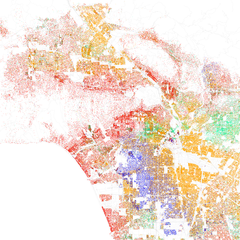
The largest Asian ethnic groups are Filipinos (3.2%) and Koreans (2.9%), which have their own established ethnic enclaves—Koreatown in the Wilshire Center and Historic Filipinotown.[143] Chinese people, which make up 1.8% of Los Angeles's population, reside mostly outside of Los Angeles city limits, in the San Gabriel Valley of eastern Los Angeles County, but make a sizable presence in the city, notably in Chinatown.[144] Chinatown and Thaitown are also home to many Thais and Cambodians, which make up 0.3% and 0.1% of Los Angeles's population, respectively. The Japanese comprise 0.9% of the city's population and have an established Little Tokyo in the city's downtown, and another significant community of Japanese Americans is in the Sawtelle district of West Los Angeles. Vietnamese make up 0.5% of Los Angeles's population. Indians make up 0.9% of the city's population. Los Angeles is also home to Armenians, Assyrians, and Iranians, many of whom live in enclaves like Little Armenia and Tehrangeles.[145][146]
African Americans have been the predominant ethnic group in South Los Angeles, which has emerged as the largest African-American community in the western United States since the 1960s. The neighborhoods of South Los Angeles with highest concentration of African Americans include Crenshaw, Baldwin Hills, Leimert Park, Hyde Park, Gramercy Park, Manchester Square and Watts.[147] There is also a sizable Eritrean and Ethiopian community in the Fairfax region.[148]
Los Angeles has the second-largest Mexican, Armenian, Salvadoran, Filipino, and Guatemalan populations by city in the world, the third-largest Canadian population in the world, and has the largest Japanese, Iranian/Persian, Cambodian, and Romani (Gypsy) populations in the country.[149] The Italian community is concentrated in San Pedro.[150]
Most of Los Angeles' foreign-born population were born in Mexico, El Salvador, Guatemala, the Philippines and South Korea.[151]
Religion
According to a 2014 study by the Pew Research Center, Christianity is the most prevalently practiced religion in Los Angeles (65%).[152][153] The Roman Catholic Archdiocese of Los Angeles is the largest archdiocese in the country.[154] Cardinal Roger Mahony, as the archbishop, oversaw construction of the Cathedral of Our Lady of the Angels, which opened in September 2002 in Downtown Los Angeles.[155]
In 2011, the once common, but ultimately lapsed, custom of conducting a procession and Mass in honor of Nuestra Señora de los Ángeles, in commemoration of the founding of the City of Los Angeles in 1781, was revived by the Queen of Angels Foundation and its founder Mark Albert, with the support of the Archdiocese of Los Angeles as well as several civic leaders.[156] The recently revived custom is a continuation of the original processions and Masses that commenced on the first anniversary of the founding of Los Angeles in 1782 and continued for nearly a century thereafter.
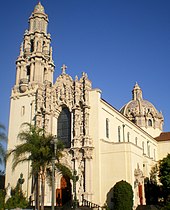
With 621,000 Jews in the metropolitan area, the region has the second-largest population of Jews in the United States, after New York City.[157] Many of Los Angeles's Jews now live on the Westside and in the San Fernando Valley, though Boyle Heights once had a large Jewish population prior to World War II due to restrictive housing covenants. Major Orthodox Jewish neighborhoods include Hancock Park, Pico-Robertson, and Valley Village, while Jewish Israelis are well represented in the Encino and Tarzana neighborhoods, and Persian Jews in Beverly Hills. Many varieties of Judaism are represented in the greater Los Angeles area, including Reform, Conservative, Orthodox, and Reconstructionist. The Breed Street Shul in East Los Angeles, built in 1923, was the largest synagogue west of Chicago in its early decades; it is no longer in daily use as a synagogue and is being converted to a museum and community center.[158][159] The Kabbalah Centre also has a presence in the city.[160]
The International Church of the Foursquare Gospel was founded in Los Angeles by Aimee Semple McPherson in 1923 and remains headquartered there to this day. For many years, the church convened at Angelus Temple, which, at its construction, was one of the largest churches in the country.[161]
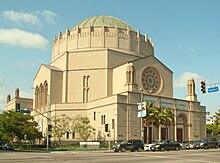
Los Angeles has had a rich and influential Protestant tradition. The first Protestant service in Los Angeles was a Methodist meeting held in a private home in 1850 and the oldest Protestant church still operating, First Congregational Church, was founded in 1867.[162] In the early 1900s the Bible Institute Of Los Angeles published the founding documents of the Christian Fundamentalist movement and the Azusa Street Revival launched Pentecostalism.[162] The Metropolitan Community Church also had its origins in the Los Angeles area.[163] Important churches in the city include First Presbyterian Church of Hollywood, Bel Air Presbyterian Church, First African Methodist Episcopal Church of Los Angeles, West Angeles Church of God in Christ, Second Baptist Church, Crenshaw Christian Center, McCarty Memorial Christian Church, and First Congregational Church.

The Los Angeles California Temple, the second-largest temple operated by the Church of Jesus Christ of Latter-day Saints, is on Santa Monica Boulevard in the Westwood neighborhood of Los Angeles. Dedicated in 1956, it was the first temple of the Church of Jesus Christ of Latter-day Saints built in California and it was the largest in the world when completed.[164]
The Hollywood region of Los Angeles also has several significant headquarters, churches, and the Celebrity Center of Scientology.[165][166]
Because of Los Angeles's large multi-ethnic population, a wide variety of faiths are practiced, including Buddhism, Hinduism, Islam, Zoroastrianism, Sikhism, Baháʼí, various Eastern Orthodox Churches, Sufism, Shintoism, Taoism, Confucianism, Chinese folk religion and countless others. Immigrants from Asia for example, have formed a number of significant Buddhist congregations making the city home to the greatest variety of Buddhists in the world. The first Buddhist joss house was founded in the city in 1875.[162] Atheism and other secular beliefs are also common, as the city is the largest in the Western U.S. Unchurched Belt.
Homelessness

As of January 2020, there are 41,290 homeless people in the City of Los Angeles, comprising roughly 62% of the homeless population of LA County.[167] This is an increase of 14.2% over the previous year (with a 12.7% increase in the overall homeless population of LA County).[168][169] The epicenter of homelessness in Los Angeles is the Skid Row neighborhood, which contains 8,000 homeless people, one of the largest stable populations of homeless people in the United States.[170][171] The increased homeless population in Los Angeles has been attributed to lack of housing affordability[172] and to substance abuse.[173] Almost 60 percent of the 82,955 people who became newly homeless in 2019 said their homelessness was because of economic hardship.[168] In Los Angeles, black people are roughly four times more likely to experience homelessness.[168][174]
Economy
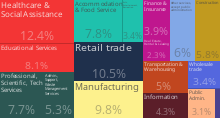
The economy of Los Angeles is driven by international trade, entertainment (television, motion pictures, video games, music recording, and production), aerospace, technology, petroleum, fashion, apparel, and tourism.[175] Other significant industries include finance, telecommunications, law, healthcare, and transportation. In the 2017 Global Financial Centres Index, Los Angeles was ranked the 19th most competitive financial center in the world and sixth most competitive in the U.S. after New York City, San Francisco, Chicago, Boston, and Washington, D.C.[176] Although a business exodus has occurred away from Downtown Los Angeles since the COVID-19 pandemic, efforts are underway to re-invent the city's urban core as a cultural center with the world's largest showcase of architecture designed by Frank Gehry.[26]
Of the five major film studios, only Paramount Pictures is within Los Angeles' city limits;[177] it is located in the so-called Thirty-Mile Zone of entertainment headquarters in Southern California.
Los Angeles is the largest manufacturing center in the United States.[178] The contiguous ports of Los Angeles and Long Beach together comprise the busiest port in the United States by some measures and the fifth busiest port in the world, vital to trade within the Pacific Rim.[179]

The Los Angeles metropolitan area has a gross metropolitan product of over $1.0 trillion (as of 2018[update]),[25] making it the third-largest economic metropolitan area in the world, after New York and Tokyo.[25] Los Angeles has been classified an "alpha world city" according to a 2012 study by a group at Loughborough University.[180]
The Department of Cannabis Regulation enforces cannabis legislation after the legalization of the sale and distribution of cannabis in 2016.[181] As of October 2019[update], more than 300 existing cannabis businesses (both retailers and their suppliers) have been granted approval to operate in what is considered the nation's largest market.[182][183]
As of 2018[update], Los Angeles is home to three Fortune 500 companies: AECOM, CBRE Group, and Reliance Steel & Aluminum Co.[184] Other companies headquartered in Los Angeles and the surrounding metropolitan area include The Aerospace Corporation, California Pizza Kitchen,[185] Capital Group Companies, Deluxe Entertainment Services Group, Dine Brands Global, DreamWorks Animation, Dollar Shave Club, Fandango Media, Farmers Insurance Group, Forever 21, Hulu, Panda Express, SpaceX, Ubisoft Film & Television, The Walt Disney Company, Universal Pictures, Warner Bros., Warner Music Group, and Trader Joe's.

| Largest non-government employers in Los Angeles County, June 2022[186] | ||
|---|---|---|
| Rank | Employer | Employees |
| 1 | Kaiser Permanente | 40,303 |
| 2 | University of Southern California | 22,735 |
| 3 | Northrop Grumman Corp. | 18,000 |
| 4 | Cedars-Sinai Medical Center | 16,659 |
| 5 | Target Corp. | 15,888 |
| 6 | Allied Universal | 15,326 |
| 7 | Providence Health and Services Southern California | 14,935 |
| 8 | Ralphs/Food 4 Less (Kroger Co. Division) | 14,000 |
| 9 | Walmart | 14,000 |
| 10 | Walt Disney Co. | 12,200 |
Arts and culture
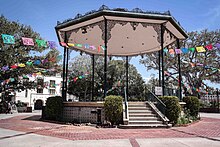
Los Angeles is often billed as the creative capital of the world because one in every six of its residents works in a creative industry[187] and there are more artists, writers, filmmakers, actors, dancers and musicians living and working in Los Angeles than any other city at any other time in world history.[188] The city is also known for its prolific murals.[189]
Landmarks
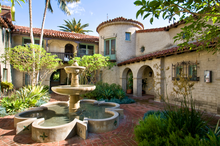
The architecture of Los Angeles is influenced by its Spanish, Mexican, and American roots. Popular styles in the city include Spanish Colonial Revival style, Mission Revival style, California Churrigueresque style, Mediterranean Revival style, Art Deco style, and Mid-Century Modern style, among others.
Important landmarks in Los Angeles include the Hollywood Sign,[190] Walt Disney Concert Hall, Capitol Records Building,[191] the Cathedral of Our Lady of the Angels,[192] Angels Flight,[193] Grauman's Chinese Theatre,[194] Dolby Theatre,[195] Griffith Observatory,[196] Getty Center,[197] Getty Villa,[198] Stahl House,[199] the Los Angeles Memorial Coliseum, L.A. Live,[200] the Los Angeles County Museum of Art, the Venice Canal Historic District and boardwalk, Theme Building, Bradbury Building, U.S. Bank Tower, Wilshire Grand Center, Hollywood Boulevard, Los Angeles City Hall, Hollywood Bowl,[201] battleship USS Iowa, Watts Towers,[202] Crypto.com Arena, Dodger Stadium, and Olvera Street.[203]
Movies and the performing arts

The performing arts play a major role in Los Angeles's cultural identity. According to the USC Stevens Institute for Innovation, "there are more than 1,100 annual theatrical productions and 21 openings every week."[188] The Los Angeles Music Center is "one of the three largest performing arts centers in the nation", with more than 1.3 million visitors per year.[204] The Walt Disney Concert Hall, centerpiece of the Music Center, is home to the prestigious Los Angeles Philharmonic.[205] Notable organizations such as Center Theatre Group, the Los Angeles Master Chorale, and the Los Angeles Opera are also resident companies of the Music Center.[206][207][208] Talent is locally cultivated at premier institutions such as the Colburn School and the USC Thornton School of Music.
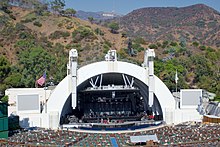
The city's Hollywood neighborhood has been recognized as the center of the motion picture industry, having held this distinction since the early 20th century, and the Los Angeles area is also associated with being the center of the television industry.[209] The city is home to major film studios as well as major record labels. Los Angeles plays host to the annual Academy Awards, the Primetime Emmy Awards, the Grammy Awards as well as many other entertainment industry awards shows. Los Angeles is the site of the USC School of Cinematic Arts which is the oldest film school in the United States.[210]
Museums and galleries

There are 841 museums and art galleries in Los Angeles County,[211] more museums per capita than any other city in the U.S.[211] Some of the notable museums are the Los Angeles County Museum of Art (the largest art museum in the Western United States[212]), the Getty Center (part of the J. Paul Getty Trust, the world's wealthiest art institution[213]), the Petersen Automotive Museum,[214] the Huntington Library,[215] the Natural History Museum,[216] the Battleship Iowa,[217] The Broad, which houses over 2,000 works of contemporary art[218] and the Museum of Contemporary Art.[219] A significant number of art galleries are on Gallery Row, and tens of thousands attend the monthly Downtown Art Walk there.[220]
Libraries
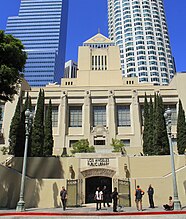
The Los Angeles Public Library system operates 72 public libraries in the city.[221] Enclaves of unincorporated areas are served by branches of the County of Los Angeles Public Library, many of which are within walking distance to residents.[222]
Cuisine
Los Angeles' food culture is a fusion of global cuisine brought on by the city's rich immigrant history and population. As of 2022, the Michelin Guide recognized 10 restaurants granting 2 restaurants two stars and eight restaurants one star.[223]
Latin American immigrants, particularly Mexican immigrants, brought tacos, burritos, quesadillas, tortas, tamales, and enchiladas served from food trucks and stands, taquerias, and cafés. Asian restaurants, many immigrant-owned, exist throughout the city with hotspots in Chinatown,[224] Koreatown,[225] and Little Tokyo.[226] Los Angeles also carries an outsized offering of vegan, vegetarian, and plant-based options.
Sports

Los Angeles and its metropolitan area are the home of eleven top-level professional sports teams, several of which play in neighboring communities but use Los Angeles in their name. These teams include the Los Angeles Dodgers[227] and Los Angeles Angels[228] of Major League Baseball (MLB), the Los Angeles Rams[229] and Los Angeles Chargers of the National Football League (NFL), the Los Angeles Lakers[230] and Los Angeles Clippers[231] of the National Basketball Association (NBA), the Los Angeles Kings[232] and Anaheim Ducks[233] of the National Hockey League (NHL), the Los Angeles Galaxy[234] and Los Angeles FC[235] of Major League Soccer (MLS), the Los Angeles Sparks of the Women's National Basketball Association (WNBA),[236] the SoCal Lashings of the Minor League Cricket (MiLC) and the Los Angeles Knight Riders of the Major League Cricket (MLC).[237]
Other notable sports teams include the UCLA Bruins and the USC Trojans in the National Collegiate Athletic Association (NCAA), both of which are Division I teams in the Pac-12 Conference, but will soon be moving to the Big Ten Conference.[238]

Los Angeles is the second-largest city in the United States but hosted no NFL team between 1995 and 2015. At one time, the Los Angeles area hosted two NFL teams: the Rams and the Raiders. Both left the city in 1995, with the Rams moving to St. Louis, and the Raiders moving back to their original home of Oakland. After 21 seasons in St. Louis, on January 12, 2016, the NFL announced the Rams would be moving back to Los Angeles for the 2016 NFL season with its home games played at the Los Angeles Memorial Coliseum for four seasons.[239][240][241] Prior to 1995, the Rams played their home games in the Coliseum from 1946 to 1979 which made them the first professional sports team to play in Los Angeles, and then moved to Anaheim Stadium from 1980 until 1994. The San Diego Chargers announced on January 12, 2017, that they would also relocate back to Los Angeles (the first since its inaugural season in 1960) and become the Los Angeles Chargers beginning in the 2017 NFL season and played at Dignity Health Sports Park in Carson, California for three seasons.[242] The Rams and the Chargers would soon move to the newly built SoFi Stadium, located in nearby Inglewood during the 2020 season.[243]

Los Angeles boasts a number of sports venues, including Dodger Stadium,[244] the Los Angeles Memorial Coliseum,[245] BMO Stadium[246] and the Crypto.com Arena.[247] The Forum, SoFi Stadium, Dignity Health Sports Park, the Rose Bowl, Angel Stadium, and the Honda Center are also in adjacent cities and cities in Los Angeles's metropolitan area.[248]
Los Angeles has twice hosted the Summer Olympic Games: in 1932 and in 1984, and will host the games for a third time in 2028.[249] Los Angeles will be the third city after London (1908, 1948 and 2012) and Paris (1900, 1924 and 2024) to host the Olympic Games three times. When the tenth Olympic Games were hosted in 1932, the former 10th Street was renamed Olympic Blvd. Los Angeles also hosted the Deaflympics in 1985[250] and Special Olympics World Summer Games in 2015.[251]

Eight NFL Super Bowls were also held in the city and its surrounding areas - two at the Memorial Coliseum (the first Super Bowl, I and VII), five at the Rose Bowl in suburban Pasadena (XI, XIV, XVII, XXI, and XXVII), and one at the suburban Inglewood (LVI).[252] The Rose Bowl also hosts an annual and highly prestigious NCAA college football game called the Rose Bowl, which happens every New Year's Day.
Los Angeles also hosted eight FIFA World Cup soccer games at the Rose Bowl in 1994, including the final, where Brazil won. The Rose Bowl also hosted four matches in the 1999 FIFA Women's World Cup, including the final, where the United States won against China on penalty kicks. This was the game where Brandi Chastain took her shirt off after she scored the tournament-winning penalty kick, creating an iconic image. Los Angeles will be one of eleven U.S. host cities for the 2026 FIFA World Cup with matches set to be held at SoFi Stadium.[253]
Los Angeles is one of six North American cities to have won championships in all five of its major leagues (MLB, NFL, NHL, NBA and MLS), having completed the feat with the Kings' 2012 Stanley Cup title.[254]
Government

Los Angeles is a charter city as opposed to a general law city. The current charter was adopted on June 8, 1999, and has been amended many times.[255] The elected government consists of the Los Angeles City Council and the mayor of Los Angeles, which operate under a mayor–council government, as well as the city attorney (not to be confused with the district attorney, a county office) and controller. The mayor is Karen Bass.[256] There are 15 city council districts.
The city has many departments and appointed officers, including the Los Angeles Police Department (LAPD),[257] the Los Angeles Board of Police Commissioners,[258] the Los Angeles Fire Department (LAFD),[259] the Housing Authority of the City of Los Angeles (HACLA),[260] the Los Angeles Department of Transportation (LADOT),[261] and the Los Angeles Public Library (LAPL).[262]
The charter of the City of Los Angeles ratified by voters in 1999 created a system of advisory neighborhood councils that would represent the diversity of stakeholders, defined as those who live, work or own property in the neighborhood. The neighborhood councils are relatively autonomous and spontaneous in that they identify their own boundaries, establish their own bylaws, and elect their own officers. There are about 90 neighborhood councils.
Residents of Los Angeles elect supervisors for the 1st, 2nd, 3rd, and 4th supervisorial districts.
Federal and state representation
In the California State Assembly, Los Angeles is split between fourteen districts.[263] In the California State Senate, the city is split between eight districts.[264] In the United States House of Representatives, it is split among nine congressional districts.[265]
Crime

In 1992, the city of Los Angeles recorded 1,092 murders.[266] Los Angeles experienced a significant decline in crime in the 1990s and late 2000s and reached a 50-year low in 2009 with 314 homicides.[267][268] This is a rate of 7.85 per 100,000 population—a major decrease from 1980 when a homicide rate of 34.2 per 100,000 was reported.[269][270] This included 15 officer-involved shootings. One shooting led to the death of a SWAT team member, Randal Simmons, the first in LAPD's history.[271] Los Angeles in the year of 2013 totaled 251 murders, a decrease of 16 percent from the previous year. Police speculate the drop resulted from a number of factors, including young people spending more time online.[272] In 2021, murders rose to the highest level since 2008 and there were 348.[273]
In 2015, it was revealed that the LAPD had been under-reporting crime for eight years, making the crime rate in the city appear much lower than it really was.[274][275]
The Dragna crime family and Mickey Cohen dominated organized crime in the city during the Prohibition era[276] and reached its peak during the 1940s and 1950s with the "Battle of Sunset Strip" as part of the American Mafia, but has gradually declined since then with the rise of various black and Hispanic gangs in the late 1960s and early 1970s.[276]
According to the Los Angeles Police Department, the city is home to 45,000 gang members, organized into 450 gangs.[277] Among them are the Crips and Bloods, which are both African American street gangs that originated in the South Los Angeles region. Latino street gangs such as the Sureños, a Mexican American street gang, and Mara Salvatrucha, which has mainly members of Salvadoran descent, as well as other Central American descents, all originated in Los Angeles. This has led to the city being referred to as the "Gang Capital of America".[278]
Education
Colleges and universities
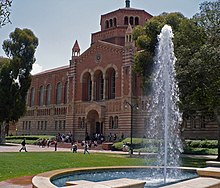



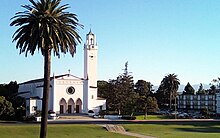
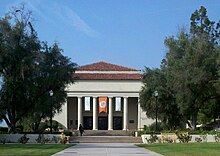
There are three public universities within the city limits: California State University, Los Angeles (CSULA), California State University, Northridge (CSUN) and University of California, Los Angeles (UCLA).[279]
Private colleges in the city include:
- American Film Institute Conservatory[280]
- Alliant International University[281]
- American Academy of Dramatic Arts (Los Angeles Campus)[282]
- American Jewish University[283]
- Abraham Lincoln University[284]
- The American Musical and Dramatic Academy – Los Angeles campus
- Antioch University's Los Angeles campus[285]
- Charles R. Drew University of Medicine and Science[286]
- Colburn School[287]
- Columbia College Hollywood[288]
- Emerson College (Los Angeles Campus)[289]
- Emperor's College[290]
- Fashion Institute of Design & Merchandising's Los Angeles campus (FIDM)
- Los Angeles Film School[291]
- Loyola Marymount University (LMU is also the parent university of Loyola Law School in Los Angeles)[292]
- Mount St. Mary's College[293]
- National University of California[294]
- Occidental College ("Oxy")[295]
- Otis College of Art and Design (Otis)[296]
- Southern California Institute of Architecture (SCI-Arc)[297]
- Southwestern Law School[298]
- University of Southern California (USC)[299]
- Woodbury University[300]
The community college system consists of nine campuses governed by the trustees of the Los Angeles Community College District:
- East Los Angeles College (ELAC)[301]
- Los Angeles City College (LACC)[302]
- Los Angeles Harbor College[303]
- Los Angeles Mission College[304]
- Los Angeles Pierce College[305]
- Los Angeles Valley College (LAVC)[306]
- Los Angeles Southwest College[307]
- Los Angeles Trade-Technical College[308]
- West Los Angeles College[309]
There are numerous additional colleges and universities outside the city limits in the Greater Los Angeles area, including the Claremont Colleges consortium, which includes the most selective liberal arts colleges in the U.S., and the California Institute of Technology (Caltech), one of the top STEM-focused research institutions in the world.
Schools
Los Angeles Unified School District serves almost all of the city of Los Angeles, as well as several surrounding communities, with a student population around 800,000.[310] After Proposition 13 was approved in 1978, urban school districts had considerable trouble with funding. LAUSD has become known for its underfunded, overcrowded and poorly maintained campuses, although its 162 Magnet schools help compete with local private schools.
Several small sections of Los Angeles are in the Inglewood Unified School District,[311] and the Las Virgenes Unified School District.[312] The Los Angeles County Office of Education operates the Los Angeles County High School for the Arts.
Media
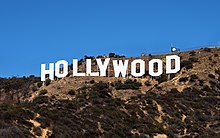
The Los Angeles metro area is the second-largest broadcast designated market area in the U.S. (after New York) with 5,431,140 homes (4.956% of the U.S.), which is served by a wide variety of local AM and FM radio and television stations. Los Angeles and New York City are the only two media markets to have seven VHF allocations assigned to them.[313]
The major daily English-language newspaper in the area is the Los Angeles Times.[314] La Opinión is the city's major daily Spanish-language paper.[315] The Korea Times is the city's major daily Korean-language paper while The World Journal is the city and county's major Chinese newspaper. The Los Angeles Sentinel is the city's major African-American weekly paper, boasting the largest African-American readership in the Western United States.[316] Investor's Business Daily is distributed from its LA corporate offices, which are headquartered in Playa del Rey.[317]
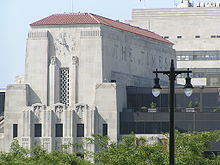
As part of the region's aforementioned creative industry, the Big Five major broadcast television networks, ABC, CBS, FOX, NBC, and The CW, all have production facilities and offices throughout various areas of Los Angeles. All four major broadcast television networks, plus major Spanish-language networks Telemundo and Univision, also own and operate stations that both serve the Los Angeles market and serve as each network's West Coast flagship station: ABC's KABC-TV (Channel 7),[318] CBS's KCBS-TV (Channel 2), Fox's KTTV-TV (Channel 11),[319] NBC's KNBC-TV (Channel 4),[320] The CW's KTLA-TV (Channel 5), MyNetworkTV's KCOP-TV (Channel 13), Telemundo's KVEA-TV (Channel 52), and Univision's KMEX-TV (Channel 34). The region also has four PBS member stations, with KCET, re-joining the network as secondary affiliate in August 2019, after spending the previous eight years as the nation's largest independent public television station. KTBN (Channel 40) is the flagship station of the religious Trinity Broadcasting Network, based out of Santa Ana. A variety of independent television stations, such as KCAL-TV (Channel 9), also operate in the area.
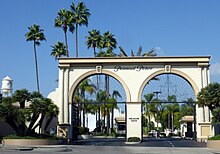
There are also a number of smaller regional newspapers, alternative weeklies and magazines, including the Los Angeles Register, Los Angeles Community News, (which focuses on coverage of the greater Los Angeles area), Los Angeles Daily News (which focuses coverage on the San Fernando Valley), LA Weekly, L.A. Record (which focuses coverage on the music scene in the Greater Los Angeles Area), Los Angeles Magazine, the Los Angeles Business Journal, the Los Angeles Daily Journal (legal industry paper), The Hollywood Reporter, Variety (both entertainment industry papers), and Los Angeles Downtown News.[321] In addition to the major papers, numerous local periodicals serve immigrant communities in their native languages, including Armenian, English, Korean, Persian, Russian, Chinese, Japanese, Hebrew, and Arabic. Many cities adjacent to Los Angeles also have their own daily newspapers whose coverage and availability overlaps with certain Los Angeles neighborhoods. Examples include The Daily Breeze (serving the South Bay), and The Long Beach Press-Telegram.
Los Angeles arts, culture and nightlife news is also covered by a number of local and national online guides, including Time Out Los Angeles, Thrillist, Kristin's List, DailyCandy, Diversity News Magazine, LAist, and Flavorpill.[322][323][324][325]
Infrastructure
Transportation
Freeways

The city and the rest of the Los Angeles metropolitan area are served by an extensive network of freeways and highways. Texas Transportation Institute's annual Urban Mobility Report ranked Los Angeles area roads the most congested in the United States in 2019 as measured by annual delay per traveler, area residents experiencing a cumulative average of 119 hours waiting in traffic that year.[326] Los Angeles was followed by San Francisco/Oakland, Washington, D.C., and Miami. Despite the congestion in the city, the mean daily travel time for commuters in Los Angeles is shorter than other major cities, including New York City, Philadelphia and Chicago. Los Angeles's mean travel time for work commutes in 2006 was 29.2 minutes, similar to those of San Francisco and Washington, D.C.[327]
The major highways that connect LA to the rest of the nation include Interstate 5, which runs south through San Diego to Tijuana in Mexico and north through Sacramento, Portland, and Seattle to the Canada–US border; Interstate 10, the southernmost east–west, coast-to-coast Interstate Highway in the United States, going to Jacksonville, Florida; and U.S. Route 101, which heads to the California Central Coast, San Francisco, the Redwood Empire, and the Oregon and Washington coasts.
Buses

The Los Angeles County Metropolitan Transportation Authority (LACMTA; branded as Metro) and other regional agencies provide a comprehensive bus system that covers Los Angeles County. While the Los Angeles Department of Transportation is responsible for contracting local and commuter bus services primarily within the city limits of Los Angeles and several immediate neighboring municipalities in southwest Los Angeles County,[328] the largest bus system in the city is operated by Metro.[329] Called Los Angeles Metro Bus, the system consists of 117 routes (excluding Metro Busway) throughout Los Angeles and neighboring cities primarily in southwestern Los Angeles County, with most routes following along a particular street in the city's street grid and run to or through Downtown Los Angeles.[330] As of the third quarter of 2023, the system had an average ridership of approximately 692,500 per weekday, with a total of 197,950,700 riders in 2022.[331] Metro also runs two Metro Busway lines, the G and J lines, which are bus rapid transit lines with stops and frequencies similar to those of Los Angeles's light rail system.
There are also smaller regional public transit systems that mainly serve specific cities or regions in Los Angeles County. For example, the Big Blue Bus provides extensive bus service in Santa Monica and western Los Angeles County, while Foothill Transit focuses on routes in the San Gabriel Valley in southeast Los Angeles County with one express route going into downtown Los Angeles. Los Angeles World Airports also runs two frequent FlyAway express bus routes (via freeways) from Los Angeles Union Station and Van Nuys to Los Angeles International Airport.[332]
While cash is accepted on all buses, the primary payment method for Los Angeles Metro Bus, Metro Busway, and 27 other regional bus agencies is a TAP card, a contactless stored-value card.[333] According to the 2016 American Community Survey, 9.2% of working Los Angeles (city) residents made the journey to work via public transportation.[334]
Rail
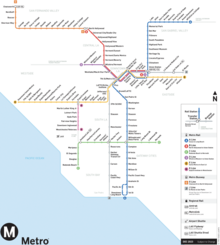
The Los Angeles County Metropolitan Transportation Authority also operate a subway and light rail system across Los Angeles and its county. The system is called Los Angeles Metro Rail and consists of the B and D subway lines, as well as the A, C, E, and K light rail lines.[330] TAP cards are required for all Metro Rail trips.[335] As of the third quarter of 2023, the city's subway system is the ninth busiest in the United States, and its light rail system is the country's second busiest.[331] In 2022, the system had a ridership of 57,299,800, or about 189,200 per weekday, in the third quarter of 2023.[331]
Since the opening of the first line, the A Line, in 1990, the system has been extended significantly, with more extensions currently in progress. Today, the system serves numerous areas across the county on 107.4 mi (172.8 km) of rail, including Long Beach, Pasadena, Santa Monica, Norwalk, El Segundo, North Hollywood, Inglewood, and Downtown Los Angeles. As of 2023, there are 101 stations in the Metro Rail system.[336]

Los Angeles is also center of its county's commuter rail system, Metrolink, which links Los Angeles to Ventura, Orange, Riverside, San Bernardino, and San Diego Counties. The system consists of eight lines and 69 stations operating on 545.6 miles (878.1 kilometres) of track.[337] Metrolink averages 42,600 trips per weekday, the busiest line being the San Bernardino Line.[338] Apart from Metrolink, Los Angeles is also connected to other cities by intercity passenger trains from Amtrak on five different lines.[339] One of the lines is the Pacific Surfliner route which operates multiple daily round trips between San Diego and San Luis Obispo, California through Union Station.[340] It is Amtrak's busiest line outside the Northeast Corridor.[341]

The main rail station in the city is Union Station which opened in 1939, and it is the largest passenger rail terminal in the Western United States.[342] The station is a major regional train station for Amtrak, Metrolink and Metro Rail. The station is Amtrak's fifth busiest station, having 1.4 million Amtrak boardings and de-boardings in 2019.[343] Union Station also offers access to Metro Bus, Greyhound, LAX FlyAway, and other buses from different agencies.[344]
Airports
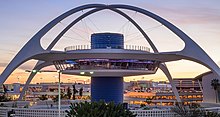
The main international and domestic airport serving Los Angeles is Los Angeles International Airport (IATA: LAX, ICAO: KLAX), commonly referred to by its airport code, LAX.[345] It is located on the Westside of Los Angeles near the Sofi Stadium in Inglewood.
Other major nearby commercial airports include:
- (IATA: ONT, ICAO: KONT) Ontario International Airport, owned by the city of Ontario, CA; serves the Inland Empire.[346]
- (IATA: BUR, ICAO: KBUR) Hollywood Burbank Airport, jointly owned by the cities of Burbank, Glendale, and Pasadena. Formerly known as Bob Hope Airport and Burbank Airport, the closest airport to Downtown Los Angeles serves the San Fernando, San Gabriel, and Antelope Valleys.[347]
- (IATA: LGB, ICAO: KLGB) Long Beach Airport, serves the Long Beach/Harbor area.[348]
- (IATA: SNA, ICAO: KSNA) John Wayne Airport of Orange County.
One of the world's busiest general-aviation airports is also in Los Angeles: Van Nuys Airport (IATA: VNY, ICAO: KVNY).[349]
Seaports
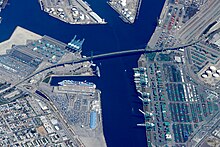
The Port of Los Angeles is in San Pedro Bay in the San Pedro neighborhood, approximately 20 miles (32 km) south of Downtown. Also called Los Angeles Harbor and WORLDPORT LA, the port complex occupies 7,500 acres (30 km2) of land and water along 43 miles (69 km) of waterfront. It adjoins the separate Port of Long Beach.[350]
The sea ports of the Port of Los Angeles and Port of Long Beach together make up the Los Angeles/Long Beach Harbor.[351][352] Together, both ports are the fifth busiest container port in the world, with a trade volume of over 14.2 million TEU's in 2008.[353] Singly, the Port of Los Angeles is the busiest container port in the United States and the largest cruise ship center on the West Coast of the United States – The Port of Los Angeles's World Cruise Center served about 590,000 passengers in 2014.[354]
There are also smaller, non-industrial harbors along Los Angeles's coastline. The port includes four bridges: the Vincent Thomas Bridge, Henry Ford Bridge, Long Beach International Gateway Bridge, and Commodore Schuyler F. Heim Bridge. Passenger ferry service from San Pedro to the city of Avalon (and Two Harbors) on Santa Catalina Island is provided by Catalina Express.
Notable people
Sister cities
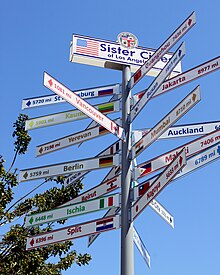
Los Angeles has 25 sister cities,[355] listed chronologically by year joined:
 Eilat, Israel (1959)
Eilat, Israel (1959) Nagoya, Japan (1959)
Nagoya, Japan (1959) Salvador, Brazil (1962)
Salvador, Brazil (1962) Bordeaux, France (1964)[356][357]
Bordeaux, France (1964)[356][357] Berlin, Germany (1967)[358]
Berlin, Germany (1967)[358] Lusaka, Zambia (1968)
Lusaka, Zambia (1968) Mexico City, Mexico (1969)
Mexico City, Mexico (1969) Auckland, New Zealand (1971)
Auckland, New Zealand (1971) Busan, South Korea (1971)
Busan, South Korea (1971) Mumbai, India (1972)
Mumbai, India (1972) Tehran, Iran (1972)
Tehran, Iran (1972) Taipei, Taiwan (1979)
Taipei, Taiwan (1979) Guangzhou, China (1981)[359]
Guangzhou, China (1981)[359] Athens, Greece (1984)
Athens, Greece (1984) Saint Petersburg, Russia (1984)
Saint Petersburg, Russia (1984) Vancouver, Canada (1986)[360]
Vancouver, Canada (1986)[360] Giza, Egypt (1989)
Giza, Egypt (1989) Jakarta, Indonesia (1990)
Jakarta, Indonesia (1990) Kaunas, Lithuania (1991)
Kaunas, Lithuania (1991) Makati, Philippines (1992)
Makati, Philippines (1992) Split, Croatia (1993)[361]
Split, Croatia (1993)[361] San Salvador, El Salvador (2005)
San Salvador, El Salvador (2005) Beirut, Lebanon (2006)
Beirut, Lebanon (2006) Ischia, Campania, Italy (2006)
Ischia, Campania, Italy (2006) Yerevan, Armenia (2007)[362]
Yerevan, Armenia (2007)[362]
In addition, Los Angeles has the following "friendship cities":
See also
- Largest cities in Southern California
- Largest cities in the Americas
- List of hotels in Los Angeles
- List of largest houses in the Los Angeles Metropolitan Area
- List of museums in Los Angeles
- List of museums in Los Angeles County, California
- List of music venues in Los Angeles
- List of people from Los Angeles
- List of tallest buildings in Los Angeles
- National Register of Historic Places listings in Los Angeles, California
- USS Los Angeles, 4 ships (including 1 airship)
Notes
- ^ US: /lɔːs ˈændʒələs/ lawss AN-jəl-əss; Spanish: Los Ángeles [los ˈaŋxeles], lit. 'The Angels'
References
- ^ Jump up to: Jump up to: a b c Gollust, Shelley (April 18, 2013). "Nicknames for Los Angeles". Voice of America. Archived from the original on July 6, 2014. Retrieved June 26, 2014.
- ^ Barrows, H.D. (1899). "Felepe de Neve". Historical Society of Southern California Quarterly. Vol. 4. p. 151ff. Archived from the original on November 6, 2023. Retrieved September 28, 2011.
- ^ "This 1835 Decree Made the Pueblo of Los Angeles a Ciudad – And California's Capital". KCET. April 2016. Archived from the original on January 28, 2018. Retrieved January 27, 2018.
- ^ "California Cities by Incorporation Date". California Association of Local Agency Formation Commissions. Archived from the original (DOC) on February 21, 2013. Retrieved August 25, 2014.
- ^ "About the City Government". City of Los Angeles. Archived from the original on February 8, 2015. Retrieved February 8, 2015.
- ^ Jump up to: Jump up to: a b "2021 U.S. Gazetteer Files". United States Census Bureau. Archived from the original on September 7, 2021. Retrieved September 7, 2021.
- ^ Jump up to: Jump up to: a b c d "QuickFacts: Los Angeles city, California". U.S. Census Bureau. Archived from the original on October 1, 2021. Retrieved January 21, 2023.
- ^ "List of 2020 Census Urban Areas". census.gov. United States Census Bureau. Archived from the original on January 14, 2023. Retrieved January 8, 2023.
- ^ "2020 Population and Housing State Data". United States Census Bureau. Archived from the original on August 12, 2021. Retrieved August 22, 2021.
- ^ "Angelino, Angeleno, and Angeleño". KCET. January 10, 2011. Archived from the original on February 19, 2023. Retrieved November 4, 2022.
- ^ "Definition of Angeleno". Merriam-Webster. May 16, 2023. Archived from the original on April 20, 2022. Retrieved April 20, 2022.
- ^ "Total Gross Domestic Product for Los Angeles-Long Beach-Anaheim, CA (MSA)". Federal Reserve Economic Data. Archived from the original on November 26, 2019. Retrieved January 3, 2024.
- ^ "Total Gross Domestic Product for Riverside-San Bernardino-Ontario, CA (MSA)". fred.stlouisfed.org. Archived from the original on June 16, 2019. Retrieved January 8, 2024.
- ^ "Total Gross Domestic Product for Oxnard-Thousand Oaks-Ventura, CA (MSA)". fred.stlouisfed.org. Archived from the original on June 16, 2019. Retrieved January 8, 2024.
- ^ Zip Codes Within the City of Los Angeles Archived July 13, 2017, at the Wayback Machine – LAHD
- ^ "Slowing State Population Decline puts Latest Population at 39,185,000" (PDF). dof.ca.gov. Archived from the original (PDF) on June 12, 2022. Retrieved June 12, 2022.
- ^ "America's 10 most visited cities" Archived June 14, 2023, at the Wayback Machine, World Atlas, September 23, 2021
- ^ Jump up to: Jump up to: a b Estrada, William David (2009). The Los Angeles Plaza: Sacred and Contested Space. University of Texas Press. pp. 15–50. ISBN 978-0-292-78209-9.
- ^ "Subterranean L.A.: The Urban Oil Fields". The Getty Iris. July 16, 2013. Archived from the original on January 1, 2016. Retrieved December 31, 2015.
- ^ Stephen Battaglio (May 15, 2024). "New York's Studio Building Boom Poses Threat to LA's Hollywood Production". Los Angeles Times. Retrieved June 11, 2024.
- ^ Ivan Ehlers (May 21, 2024). "Opinion: Studio productions keep moving out of Los Angeles. We need to stop the bleeding". Los Angeles Times. Retrieved June 11, 2024.
- ^ LaRocco, Lori Ann (September 24, 2022). "New York is now the nation's busiest port in a historic tipping point for U.S.-bound trade". CNBC. Archived from the original on June 10, 2023. Retrieved May 22, 2023.
- ^ "Port of NYNJ Beats West Coast Rivals with Highest 2023 Volumes". The Maritime Executive. Archived from the original on May 11, 2023. Retrieved May 22, 2023.
- ^ "Port of New York and New Jersey Remains US' Top Container Port". www.marinelink.com. December 28, 2022. Archived from the original on May 11, 2023. Retrieved May 22, 2023.
- ^ Jump up to: Jump up to: a b c "Table 3.1. GDP & Personal Income". U.S. Bureau of Economic Analysis. 2018. Archived from the original on October 23, 2018. Retrieved April 6, 2019.
- ^ Jump up to: Jump up to: a b Roger Vincent (April 12, 2024). "Downtown L.A. is hurting. Frank Gehry thinks arts can lead a revival". Los Angeles Times. Archived from the original on April 14, 2024. Retrieved April 14, 2024.
- ^ Jump up to: Jump up to: a b "Settlement of Los Angeles". Los Angeles Almanac. Archived from the original on September 2, 2018. Retrieved September 2, 2018.
- ^ "Ooh L.A. L.A." Los Angeles Times. December 12, 1991. Archived from the original on January 11, 2022. Retrieved October 24, 2021.
- ^ Pool, Bob (March 26, 2005). "City of Angels' First Name Still Bedevils Historians". Los Angeles Times. Archived from the original on October 21, 2021. Retrieved October 24, 2021.
- ^ Jump up to: Jump up to: a b Stein, David Allen (1953). "Los Angeles: A Noble Fight Nobly Lost". Names. 1 (1): 35–38. doi:10.1179/nam.1953.1.1.35.
- ^ Masters, Nathan (February 24, 2011). "The Crusader in Corduroy, the Land of Soundest Philosophy, and the 'G' That Shall Not Be Jellified". KCET. Public Media Group of Southern California. Archived from the original on July 9, 2021. Retrieved July 4, 2021.
- ^ Masters, Nathan (May 6, 2016). "How to Pronounce "Los Angeles," According to Charles Lummis". KCET. Public Media Group of Southern California. Archived from the original on July 9, 2021. Retrieved July 4, 2021.
- ^ Lummis, Charles Fletcher (June 29, 1908). "This Is the Way to Pronounce Los Angeles". Nebraska State Journal. p. 4. Archived from the original on July 9, 2021. Retrieved July 4, 2021.
- ^ Jump up to: Jump up to: a b c Harvey, Steve (June 26, 2011). "Devil of a time with City of Angels' name". Los Angeles Times. Archived from the original on July 9, 2021. Retrieved July 4, 2021.
- ^ Kenyon, John Samuel; Knott, Thomas Albert (1944). A Pronouncing Dictionary of American English. Springfield, Mass.: G. & C. Merriam. p. 260.
- ^ Buntin, John (2009). L.A. Noir: The Struggle for the Soul of America's Most Seductive City. New York: Harmony Books. p. 16. ISBN 978-0-307-35207-1.
- ^ Jones, Daniel (2011). Roach, Peter; Setter, Jane; Esling, John (eds.). Cambridge English Pronouncing Dictionary (18th ed.). Cambridge University Press. ISBN 978-0-521-15255-6.
- ^ Windsor Lewis, Jack (1990). "HappY land reconnoitred: the unstressed word-final -y vowel in General British pronunciation". In Ramsaran, Susan (ed.). Studies in the Pronunciation of English: A Commemorative Volume in Honour of A.C. Gimson. Routledge. pp. 159–167. ISBN 978-1-138-92111-5. Archived from the original on May 18, 2023. Retrieved June 12, 2023. Pages 166–167.
- ^ Bowman, Chris (July 8, 2008). "Smoke is Normal – for 1800". The Sacramento Bee. Archived from the original on July 9, 2008. Retrieved October 6, 2011.
- ^ Gordon J. MacDonald. "Environment: Evolution of a Concept" (PDF). p. 2. Archived (PDF) from the original on June 27, 2013. Retrieved April 16, 2013.
The Native American name for Los Angeles was Yang na, which translates into "the valley of smoke."
- ^ Bright, William (1998). Fifteen Hundred California Place Names. University of California Press. p. 86. ISBN 978-0-520-21271-8. LCCN 97043147. Archived from the original on November 6, 2023. Retrieved October 17, 2015.
Founded on the site of a Gabrielino Indian village called Yang-na, or iyáangẚ, 'poison-oak place.'
- ^ Sullivan, Ron (December 7, 2002). "Roots of native names". San Francisco Chronicle. Archived from the original on December 18, 2014. Retrieved January 7, 2015.
Los Angeles itself was built over a Gabrielino village called Yangna or iyaanga', 'poison oak place.'
- ^ Willard, Charles Dwight (1901). The Herald's History of Los Angeles. Los Angeles: Kingsley-Barnes & Neuner. pp. 21–24. ISBN 978-0-598-28043-5. Archived from the original on November 6, 2023. Retrieved September 29, 2011.
- ^ "Portola Expedition 1769 Diaries". Pacifica Historical Society. Archived from the original on November 13, 2015. Retrieved January 7, 2015.
- ^ Leffingwell, Randy; Worden, Alastair (November 4, 2005). California missions and presidios. Voyageur Press. pp. 43–44. ISBN 978-0-89658-492-1. Archived from the original on November 6, 2023. Retrieved September 30, 2011.
- ^ Mulroy, Kevin; Taylor, Quintard; Autry Museum of Western Heritage (March 2001). "The Early African Heritage in California (Forbes, Jack D.)". Seeking El Dorado: African Americans in California. University of Washington Press. p. 79. ISBN 978-0-295-98082-9. Archived from the original on November 6, 2023. Retrieved September 30, 2011.
- ^ Guinn, James Miller (1902). Historical and biographical record of southern California: containing a history of southern California from its earliest settlement to the opening year of the twentieth century. Chapman pub. co. p. 63. Archived from the original on March 18, 2023. Retrieved September 30, 2011.
- ^ Estrada, William D. (2006). Los Angeles's Olvera Street. Arcadia Publishing. ISBN 978-0-7385-3105-2. Archived from the original on November 6, 2023. Retrieved September 30, 2011.
- ^ "Pio Pico, Afro Mexican Governor of Mexican California". African American Registry. Archived from the original on February 2, 2017. Retrieved January 24, 2017.
- ^ "Monterey County Historical Society, Local History Pages--Secularization and the Ranchos, 1826-1846". mchsmuseum.com. Archived from the original on October 20, 2021. Retrieved October 26, 2017.
- ^ Bauer, K. Jack (1993). The Mexican War, 1846-1848 (Bison books ed.). Lincoln: University of Nebraska Press. p. 184. OCLC 25746154.
- ^ Guinn, James Miller (1902). Historical and biographical record of southern California: containing a history of southern California from its earliest settlement to the opening year of the twentieth century. Chapman pub. co. p. 50. Archived from the original on March 18, 2023. Retrieved September 30, 2011.
- ^ Mulholland, Catherine (2002). William Mulholland and the Rise of Los Angeles. University of California Press. p. 15. ISBN 978-0-520-23466-6. Archived from the original on November 6, 2023. Retrieved September 30, 2011.
- ^ Kipen, David (2011). Los Angeles in the 1930s: The WPA Guide to the City of Angels. University of California Press. pp. 45–46. ISBN 978-0-520-26883-8. Archived from the original on November 6, 2023. Retrieved September 30, 2011.
- ^ "Population of the 100 Largest Urban Places: 1900". United States Census Bureau. June 15, 1998. Archived from the original on February 15, 2015. Retrieved January 8, 2015.
- ^ "The Los Angeles Aqueduct and the Owens and Mono Lakes (MONO Case)". American University. Archived from the original on January 9, 2015. Retrieved January 8, 2015.
- ^ Reisner, Marc (1993). Cadillac desert: the American West and its disappearing water. Penguin. p. 86. ISBN 978-0-14-017824-1. Archived from the original on November 6, 2023. Retrieved September 30, 2011.
- ^ Basiago, Andrew D. (February 7, 1988), Water For Los Angeles – Sam Nelson Interview, The Regents of the University of California, 11, archived from the original on August 4, 2019, retrieved October 7, 2013
- ^ Annexation and Detachment Map (PDF) (Map). City of Los Angeles Bureau of Engineering. Archived from the original (PDF) on March 1, 2017. Retrieved March 1, 2017.
- ^ Creason, Glen (September 26, 2013). "CityDig: L.A.'s 20th Century Land Grab". Lamag - Culture, Food, Fashion, News & Los Angeles. Los Angeles Magazine. Archived from the original on September 29, 2013. Retrieved October 10, 2013.
- ^ Weiss, Marc A (1987). The Rise of the Community Builders: The American Real Estate Industry and Urban Land Planning. New York: Columbia University Press. pp. 80–86. ISBN 978-0-231-06505-4.
- ^ Buntin, John (April 6, 2010). L.A. Noir: The Struggle for the Soul of America's Most Seductive City. Random House Digital, Inc. p. 18. ISBN 978-0-307-35208-8. Archived from the original on November 6, 2023. Retrieved September 30, 2011.
- ^ Young, William H.; Young, Nancy K. (March 2007). The Great Depression in America: a cultural encyclopedia. Greenwood Publishing Group. p. 21. ISBN 978-0-313-33521-1. Archived from the original on November 6, 2023. Retrieved September 30, 2011.
- ^ "Population of the 100 Largest Urban Places: 1930". United States Census Bureau. June 15, 1998. Archived from the original on April 28, 2015. Retrieved January 8, 2015.
- ^ Parker, Dana T. Building Victory: Aircraft Manufacturing in the Los Angeles Area in World War II, pp.5–8, 14, 26, 36, 50, 60, 78, 94, 108, 122, Cypress, CA, 2013. ISBN 978-0-9897906-0-4.
- ^ Bruegmann, Robert (November 1, 2006). Sprawl: A Compact History. University of Chicago Press. p. 133. ISBN 978-0-226-07691-1. Archived from the original on November 6, 2023. Retrieved October 1, 2011.
- ^ Braun, Michael. "The economic impact of theme parks on regions" (PDF). Archived from the original (PDF) on December 7, 2021. Retrieved November 4, 2021.
- ^ Jennings, Jay (February 26, 2021). Beverly Park: L.A.'s Kiddieland, 1943–74. Independently published. ISBN 979-8713878917.
- ^ Монкконен, Пааво; Манвилл, Майкл; Линз, Майкл (2024). «Построенные города? Новый подход к измерению регулирования землепользования» . Журнал жилищной экономики . 63 . дои : 10.1016/j.jhe.2024.101982 . ISSN 1051-1377 .
- ^ Хинтон, Элизабет (2016). От войны с бедностью к войне с преступностью: создание массовых тюремных заключений в Америке . Издательство Гарвардского университета. стр. 68–72. ISBN 9780674737235 . Архивировано из оригинала 6 ноября 2023 года . Проверено 15 мая 2022 г.
- ^ Хафнер, Кэти ; Лион, Мэтью (1 августа 1999 г.). Где волшебники ложатся спать допоздна: истоки Интернета . Саймон и Шустер. п. 153. ИСБН 978-0-684-87216-2 . Архивировано из оригинала 6 ноября 2023 года . Проверено 1 октября 2011 г.
- ^ Вронский, Петр (2004). Серийные убийцы: Метод и безумие монстров . Пингвин. п. 187 . ISBN 0-425-19640-2 .
- ^ Ву, Элейн (30 июня 2004 г.). «Родни В. Руд, 88 лет; сыграл ключевую роль на Олимпийских играх 1984 года, обеспечив поддержку метро» . Лос-Анджелес Таймс . Архивировано из оригинала 13 декабря 2011 года . Проверено 1 октября 2011 г.
- ^ Зарновский, К. Франк (лето 1992 г.). «Взгляд на олимпийские расходы» (PDF) . Цитиус, Альтиус, Фортиус . 1 (1): 16–32. Архивировано из оригинала (PDF) 28 мая 2008 года . Проверено 1 октября 2011 г.
- ^ Ракер, Уолтер К.; Аптон, Джеймс Н.; Хьюи, Мэтью В. (2007). «Беспорядки в Лос-Анджелесе (Калифорния) 1992 года» . Энциклопедия американских расовых беспорядков . Издательская группа Гринвуд. стр. 376–85. ISBN 978-0-313-33301-9 . Архивировано из оригинала 6 ноября 2023 года . Проверено 1 октября 2011 г.
- ^ Уилсон, Стэн (25 апреля 2012 г.). «Юбилейный тур Riot посвящен прогрессу и экономическим проблемам Лос-Анджелеса» . CNN . Архивировано из оригинала 24 сентября 2015 года . Проверено 23 января 2015 г.
- ^ Райх, Кеннет (20 декабря 1995 г.). «Исследование увеличило число погибших в результате землетрясения в Нортридже до 72» . Лос-Анджелес Таймс . п. Б1. Архивировано из оригинала 13 декабря 2011 года . Проверено 1 октября 2011 г.
- ^ «Хронология скандала в Rampart» . PBS «Линия фронта» . Архивировано из оригинала 4 марта 2012 года . Проверено 1 октября 2011 г.
- ^ Орлов, Рик (3 ноября 2012 г.). «Движение за отделение изменило долину Сан-Фернандо, Лос-Анджелес» . Лос-Анджелес Дейли Ньюс . Архивировано из оригинала 25 декабря 2014 года . Проверено 12 января 2015 г.
- ^ «Карен Басс избрана мэром, став первой женщиной, возглавившей Лос-Анджелес» Los Angeles Times . 16 ноября 2022 года. Архивировано из оригинала 17 ноября 2022 года . Проверено 18 ноября 2022 г.
- ^ Горовиц, Джулия (1 августа 2017 г.). «Лос-Анджелес примет Олимпийские игры 2028 года» . CNNMoney . Архивировано из оригинала 31 июля 2017 года.
- ^ «Города, принимавшие несколько летних Олимпийских игр» . атлас мира . Архивировано из оригинала 15 декабря 2016 года.
- ^ «Файлы справочника переписи населения США 2010 года – Места – Калифорния» . Бюро переписи населения США .
- ^ «Высоты 50 крупнейших городов (по населению, перепись 1980 года)» . Геологическая служба США . Архивировано из оригинала 2 октября 2011 года . Проверено 3 октября 2011 г.
- ^ «Путеводитель по горе Люкенс» . Отделение Sierra Club в Анхелесе. Архивировано из оригинала 24 ноября 2011 года . Проверено 3 октября 2011 г.
- ^ «Карты Google» . Карты Гугл . Архивировано из оригинала 31 мая 2022 года . Проверено 31 мая 2022 г.
- ^ Гумпрехт, Блейк (март 2001 г.). Река Лос-Анджелес: ее жизнь, смерть и возможное возрождение . Джу Пресс. п. 173. ИСБН 978-0-8018-6642-5 . Архивировано из оригинала 6 ноября 2023 года . Проверено 3 октября 2011 г.
- ^ Миллер, Джордж Оксфорд (15 января 2008 г.). Ландшафтный дизайн с использованием местных растений Южной Калифорнии . Вояджер Пресс. п. 15. ISBN 978-0-7603-2967-2 . Архивировано из оригинала 6 ноября 2023 года . Проверено 6 октября 2011 г.
- ^ Национальный исследовательский совет (США). Консультативный комитет по технологическим инновациям (1979). Тропические бобовые: ресурсы для будущего: отчет специальной группы Консультативного комитета по технологическим инновациям, Совета по науке и технологиям в целях международного развития, Комиссии по международным отношениям, Национального исследовательского совета . Национальные академии. п. 258. НАП:14318. Архивировано из оригинала 6 ноября 2023 года . Проверено 6 октября 2011 г.
- ^ "Цветок" . Журнал Лос-Анджелеса . Эммис Коммуникейшнс. Апрель 2003. с. 62. ISSN 1522-9149 . Архивировано из оригинала 6 ноября 2023 года . Проверено 6 октября 2011 г.
- ^ «В 2023 году давайте добавим игрушки в наши родные сады и положим конец городской легенде» . Лос-Анджелес Таймс . 29 декабря 2022 года. Архивировано из оригинала 15 декабря 2023 года . Проверено 15 декабря 2023 г.
- ↑ Перейти обратно: Перейти обратно: а б с
- Ламберт, Макс Р.; Бранс, Кристиен И.; Де Рош, Симона; Донихью, Колин М.; Даймонд, Сара Э. (2021). «Адаптивная эволюция городов: прогресс и заблуждения». Тенденции в экологии и эволюции . 36 (3). Cell Press : 239–257. дои : 10.1016/j.tree.2020.11.002 . ISSN 0169-5347 . ПМИД 33342595 . S2CID 229342193 .
- Серийс, Лорел ЕК; Леа, Аманда; Поллинджер, Джон П.; Райли, Сет П.Д.; Уэйн, Роберт К. (2 декабря 2014 г.). «Болезни и автострады вызывают генетические изменения в городских популяциях рыси» . Эволюционные приложения . 8 (1). Блэквелл : 75–92. дои : 10.1111/eva.12226 . ISSN 1752-4571 . ПМК 4310583 . ПМИД 25667604 . S2CID 27501058 .
- ^ «Факты о землетрясении» . Геологическая служба США . Архивировано из оригинала 10 октября 2011 года . Проверено 3 октября 2011 г.
- ^ Зелински, Сара (28 мая 2015 г.). «Что на самом деле произойдет, когда Сан-Андреас выпустит на волю большого?» . Смитсоновский институт . Архивировано из оригинала 25 сентября 2020 года . Проверено 6 сентября 2020 г.
- ^ Шоу, Джон Х.; Ширер, Питер М. (5 марта 1999 г.). «Неуловимый слепой разлом под мегаполисом Лос-Анджелес». Наука . 283 (5407): 1516–1518. Бибкод : 1999Sci...283.1516S . дои : 10.1126/science.283.5407.1516 . ПМИД 10066170 . S2CID 21556124 .
- ^ «Самое большое зарегистрированное землетрясение в мире» . Геология.com. Архивировано из оригинала 19 января 2015 года . Проверено 12 января 2015 г.
- ^ «Картирование окрестностей Лос-Анджелеса» . Лос-Анджелес Таймс . Архивировано из оригинала 12 мая 2019 года . Проверено 7 июня 2019 г.
- ^ «Карта почтовых индексов Лос-Анджелеса, Калифорния» . USMapGuide . Архивировано из оригинала 9 мая 2022 года . Проверено 6 июня 2019 г.
- ^ Абу-Лугход, Джанет Л. (1999). Нью-Йорк, Чикаго, Лос-Анджелес: глобальные города Америки . Университет Миннесоты Пресс. п. 66. ИСБН 978-0-8166-3336-4 . Архивировано из оригинала 6 ноября 2023 года . Проверено 2 октября 2011 г.
- ^ «Признаки соседства» . ЛАДОТ . Архивировано из оригинала 7 сентября 2015 года.
- ^ Бауэрман, Мэри (1 апреля 2015 г.). «Лос-Анджелес возглавляет рейтинг городов с худшим дорожным движением в США» . США СЕГОДНЯ . Архивировано из оригинала 1 января 2016 года . Проверено 31 декабря 2015 г.
- ↑ Перейти обратно: Перейти обратно: а б «Сводка ежемесячных норм за 1991–2020 годы» . Национальное управление океанических и атмосферных исследований . Проверено 11 мая 2021 г.
- ^ Пил, MC; Финлейсон Б.Л. и МакМахон, Т.А. (2007). «Обновленная карта мира климатической классификации Кеппена-Гейгера» . Гидрол. Система Земли. Наука . 11 (5): 1633–1644. Бибкод : 2007HESS...11.1633P . doi : 10.5194/hess-11-1633-2007 . ISSN 1027-5606 .
- ^ Макдональд, Глен М. (22 мая 2017 г.). «Миф о пустынном мегаполисе: Лос-Анджелес не был построен в пустыне, но сделаем ли мы его таковым?» . Бум Калифорния . Архивировано из оригинала 8 марта 2019 года . Проверено 8 марта 2019 г.
- ↑ Перейти обратно: Перейти обратно: а б «Историческая погода для Лос-Анджелеса, Калифорния, Соединенные Штаты Америки» . Метеорологическая база. Архивировано из оригинала 11 января 2012 года . Проверено 15 декабря 2011 г.
- ↑ Перейти обратно: Перейти обратно: а б с д и ж г час «Климатография США № 20 (1971–2000)» (PDF) . Национальное управление океанических и атмосферных исследований . 2004. Архивировано из оригинала (PDF) 2 сентября 2013 года . Проверено 5 октября 2011 г.
- ^ «Температура Тихого океана на побережье Калифорнии» . BeachCalifornia.com. Архивировано из оригинала 12 октября 2011 года . Проверено 5 октября 2011 г.
- ^ «Климатический гид Лос-Анджелеса» . Weather2travel.com. Архивировано из оригинала 5 октября 2011 года . Проверено 5 октября 2011 г.
- ^ «Климат Калифорнии» . Западный региональный климатический центр. Архивировано из оригинала 21 июля 2009 года . Проверено 6 октября 2011 г.
- ^ Пул, Мэтью Р. (22 сентября 2010 г.). Лос-Анджелес Фроммера, 2011 год . Джон Уайли и сыновья. п. 22. ISBN 978-0-470-62619-1 . Архивировано из оригинала 6 ноября 2023 года . Проверено 5 октября 2011 г.
- ^ Смит, Хейли (1 марта 2022 г.). «Засуха в Калифорнии продолжается после того, как в штате зафиксированы самые засушливые январь и февраль за всю историю наблюдений» . Лос-Анджелес Таймс . Архивировано из оригинала 9 марта 2022 года . Проверено 23 ноября 2022 г.
- ^ «Альманах Лос-Анджелеса – среднее сезонное количество осадков» . Архивировано из оригинала 27 декабря 2021 года . Проверено 26 декабря 2021 г.
- ^ Берт, Кристофер С.; Страуд, Марк (26 июня 2007 г.). Экстремальная погода: путеводитель и книга рекордов . WW Нортон и компания. п. 100. ИСБН 978-0-393-33015-1 . Архивировано из оригинала 6 ноября 2023 года . Проверено 5 октября 2011 г.
- ^ Фрейзин, Рэйчел (21 февраля 2019 г.). «В Лос-Анджелесе выпадает первый снег за многие годы» . Холм . Capitol Hill Publishing Corp. Архивировано из оригинала 23 февраля 2019 года . Проверено 6 апреля 2019 г.
- ^ «Снег падает в Лос-Анджелесе, Пасадене и прибрежных городах Калифорнии» . nbcnews.com . НБК Универсал. 22 февраля 2019 года. Архивировано из оригинала 2 апреля 2019 года . Проверено 6 апреля 2019 г.
- ^ «Снег в Малибу? Погода преподносит сюрпризы в Южной Калифорнии» . КУСА.com . 25 января 2021 года. Архивировано из оригинала 9 мая 2022 года . Проверено 28 января 2021 г.
- ^ Пул, Боб; Линь II, Ронг-Гонг (27 сентября 2010 г.). «Самый жаркий день в Лос-Анджелесе» . Лос-Анджелес Таймс . Архивировано из оригинала 13 декабря 2011 года . Проверено 5 октября 2011 г.
- ^ Национальное управление океанических и атмосферных исследований. «Лос-Анджелес/Окснард» . Бюро прогнозов Национальной метеорологической службы . Архивировано из оригинала 18 сентября 2020 года . Проверено 9 сентября 2020 г.
- ↑ Перейти обратно: Перейти обратно: а б «NowData – онлайн-данные о погоде NOAA» . Национальное управление океанических и атмосферных исследований . Проверено 18 июля 2020 г.
- ^ «Название станции: CA LOS ANGELES DWTN USC CAMPUS» . Национальное управление океанических и атмосферных исследований . Проверено 18 июля 2020 г.
- ^ «Климатические нормы ЛОС-АНДЖЕЛЕС/WBO CA» . Национальное управление океанических и атмосферных исследований . Проверено 20 октября 2013 г.
- ^ «Исторические данные об УФ-индексе — Лос-Анджелес, Калифорния» . УФ-индекс сегодня . Проверено 21 апреля 2023 г.
- ^ «Название станции: CA LOS ANGELES INTL AP» . Национальное управление океанических и атмосферных исследований . Проверено 9 мая 2014 г.
- ^ «Сводка ежемесячных норм за 1991–2020 годы» . Национальное управление океанических и атмосферных исследований . Проверено 11 мая 2021 г.
- ^ «Климатические нормы ВМО для ЛОС-АНДЖЕЛЕСА/ИНТЛ, Калифорния, 1961–1990 гг.» . Национальное управление океанических и атмосферных исследований . Проверено 17 апреля 2014 г.
- ^ Стимсон, Томас Э. (июль 1955 г.). «Что мы можем сделать со смогом?» . Популярная механика : 65. ISSN 0032-4558 . Архивировано из оригинала 6 ноября 2023 года . Проверено 6 октября 2011 г.
- ^ «Смог висит над олимпийскими спортсменами» . New Scientist : 393. 11 августа 1983. ISSN 0262-4079 . Проверено 6 октября 2011 г.
- ^ «Раннее осуществление Закона о чистом воздухе 1970 года в Калифорнии». Ассоциация выпускников EPA. Видео, стенограмма заархивирована 12 апреля 2019 г. в Wayback Machine (см. стр. 7, 10). 12 июля 2016 г.
- ^ Марциали, Карл (4 марта 2015 г.). «История экологического успеха Лос-Анджелеса: чище воздух, здоровее дети» . Новости ОСК . Архивировано из оригинала 10 марта 2015 года . Проверено 16 марта 2015 г.
- ^ «Самые загрязненные города» . Американская ассоциация легких . Архивировано из оригинала 7 января 2015 года . Проверено 12 января 2015 г.
- ^ «Питтсбург и Лос-Анджелес — самые загрязненные города США» . citymayors.com. 4 мая 2008 года. Архивировано из оригинала 2 октября 2011 года . Проверено 7 октября 2011 г.
- ^ «Лос-Анджелес достигает 20-процентной цели по использованию возобновляемых источников энергии» . Новости Блумберга . 14 января 2011 года. Архивировано из оригинала 1 февраля 2011 года . Проверено 7 октября 2011 г.
- ^ «Состояние воздуха Американской ассоциации легких в 2013 г. – Лос-Анджелес-Лонг-Бич-Риверсайд, Калифорния» . Состояние воздуха Американской ассоциации легких, 2013 г. Архивировано из оригинала 31 августа 2015 года . Проверено 1 сентября 2015 г.
- ^ «Офицерам Агентства по охране окружающей среды стало плохо от дыма на нефтяном месторождении в Южном Лос-Анджелесе» . Лос-Анджелес Таймс . 9 ноября 2013 года. Архивировано из оригинала 8 апреля 2016 года . Проверено 24 марта 2016 г.
- ^ «Общая численность населения городов: 2020-2023 гг.» . Архивировано из оригинала 11 июля 2022 года . Проверено 19 мая 2024 г.
- ^ «Перепись населения и жилищного фонда» . Бюро переписи населения США . Архивировано из оригинала 1 июля 2021 года . Проверено 19 марта 2007 г.
- ^ «Интерактивный поиск населения по переписи населения 2010 года: Калифорния — Лос-Анджелес» . Бюро переписи населения США . Архивировано из оригинала 24 июля 2014 года . Проверено 12 июля 2014 г.
- ↑ Перейти обратно: Перейти обратно: а б с д и ж г час «Лос-Анджелес (город), Калифорния» . Бюро переписи населения США . Архивировано из оригинала 19 февраля 2021 года . Проверено 3 октября 2016 г.
- ↑ Перейти обратно: Перейти обратно: а б с д «Раса и латиноамериканское происхождение отдельных городов и других мест: самая ранняя перепись 1990 года» . Бюро переписи населения США . Архивировано из оригинала 12 августа 2012 года . Проверено 6 ноября 2015 г.
- ↑ Перейти обратно: Перейти обратно: а б «2020: Данные о перераспределении округов DEC (PL 94-171)» . Бюро переписи населения США. Архивировано из оригинала 4 июля 2022 года . Проверено 4 июля 2022 г.
- ^ «Население Лос-Анджелеса, Калифорния, 2019» . Обзор мирового населения . Архивировано из оригинала 15 июля 2019 года . Проверено 21 августа 2019 г.
- ^ «Благосостояние района и качество окружающей среды для латиноамериканских сообществ на юго-востоке Лос-Анджелеса - данные о районе для социальных изменений» . Проверено 17 июня 2024 г.
- ^ Шьонг, Фрэнк (6 января 2020 г.). «Вот как HIFI, или Исторический филиппинский город, получил свое название» . Лос-Анджелес Таймс . Архивировано из оригинала 6 января 2020 года . Проверено 6 января 2020 г.
- ^ «Добро пожаловать в китайский квартал Лос-Анджелеса» . chinatownla.com . Архивировано из оригинала 24 января 2017 года . Проверено 10 июня 2015 г.
- ^ Наджафи, Лейла (23 октября 2021 г.). «Путеводитель по Тегеранджелесу, карману иранской культуры Лос-Анджелеса» . Конде Наст Трэвелер . Проверено 17 июня 2024 г.
- ^ Посох, Пожиратель (17 августа 2016 г.). «Где поесть армянской еды в Лос-Анджелесе | MOFAD City» . Eater.com . Проверено 17 июня 2024 г.
- ^ Рэй, МэриЭллен Белл (1985). Город Уоттс, Калифорния: 1907–1926 годы . Восходящий Паб. ISBN 978-0-917047-01-5 .
- ^ Баркан, Эллиот Роберт (17 января 2013 г.). Иммигранты в американской истории: прибытие, адаптация и интеграция . Абк-Клио. п. 693. ИСБН 9781598842197 .
- ^ Хайден, Долорес (24 февраля 1997 г.). Сила места: городские пейзажи как публичная история . МТИ Пресс. п. 83. ИСБН 9780262581523 . Архивировано из оригинала 6 ноября 2023 года . Проверено 24 ноября 2022 г.
- ^ Купил, Мардж (2007). Итальянцы в Лос- Анджелесе Аркадия. ISBN 9780738547756 . Архивировано из оригинала 27 апреля 2023 года . Проверено 28 ноября 2022 г.
- ^ «Лос-Анджелес» (PDF) . dormsife.usc.edu . Архивировано (PDF) из оригинала 21 июля 2023 г. Проверено 7 августа 2023 г.
- ↑ Перейти обратно: Перейти обратно: а б «Исследование религиозного ландшафта: взрослые в районе метро Лос-Анджелеса» . Исследовательский центр Пью . 2014. Архивировано из оригинала 31 июля 2022 года . Проверено 26 июня 2023 г.
- ↑ Перейти обратно: Перейти обратно: а б «Меняющийся религиозный ландшафт Америки» . Исследовательский центр Пью : Религия и общественная жизнь. 12 мая 2015 года. Архивировано из оригинала 10 апреля 2019 года . Проверено 30 июля 2015 г.
- ^ Помфрет, Джон (2 апреля 2006 г.). «Кардинал вовлекает церковь в борьбу за права иммигрантов» . Вашингтон Пост . Архивировано из оригинала 12 июня 2018 года . Проверено 22 октября 2011 г.
- ^ Стаммер, Ларри Б.; Бесерра, Гектор (4 сентября 2002 г.). «Пышное прошлое, массы стекаются в собор» . Лос-Анджелес Таймс . Архивировано из оригинала 11 января 2012 года . Проверено 22 октября 2011 г.
- ^ Деллинджер, Роберт (6 сентября 2011 г.). «Большая процессия 2011 года возрождает основание преданности Марии в Лос-Анджелесе» (PDF) . Вести онлайн . Архивировано (PDF) из оригинала 22 февраля 2014 г. Проверено 14 января 2015 г.
- ^ «Еврейское население мира» . SimpleToRemember.com. Архивировано из оригинала 7 апреля 2012 года . Проверено 23 октября 2011 г.
- ^ «Вашингтонский симпозиум и выставка освещают вопросы восстановления и адаптивного повторного использования американских синагог» . Отчет о еврейском наследии . № 1. Март 1997 года. Архивировано из оригинала 27 марта 2011 года . Проверено 23 октября 2011 г.
- ^ «Шул на Брид-стрит в Лос-Анджелесе, спасенный политиками» . Отчет о еврейском наследии . Том. II, нет. 1–2. Весна–лето 1998. Архивировано из оригинала 27 марта 2011 года . Проверено 23 октября 2011 г.
- ^ Ласкомб, Белинда (6 августа 2006 г.). «Мадонна находит причину» . Журнал «Тайм» . Архивировано из оригинала 19 августа 2006 года . Проверено 23 октября 2011 г.
- ^ Эдит Вальдфогель Блюмхофер, Эйми Семпл Макферсон: всеобщая сестра , Wm. B. Eerdmans Publishing, США, 1993, стр. 246–247.
- ↑ Перейти обратно: Перейти обратно: а б с Клифтон Л. Холланд. «Обзор религии в Лос-Анджелесе с 1850 по 1930 годы» . Архивировано из оригинала 5 сентября 2017 года . Проверено 18 сентября 2017 г.
- ^ «История MCC – Митрополичьих общинных церквей» . www.mccchurch.org . Архивировано из оригинала 4 мая 2019 года . Проверено 28 апреля 2019 г.
- ^ «Храм СПД в Лос-Анджелесе, Калифорния» . Церковь Иисуса Христа Святых последних дней. Архивировано из оригинала 12 октября 2018 года . Проверено 23 октября 2011 г.
- ^ «Международный центр знаменитостей Саентологической церкви» . Международный центр знаменитостей Церкви Саентологии . Архивировано из оригинала 17 июня 2018 года . Проверено 17 июня 2018 г.
- ^ Миллер, Дэниел (21 июля 2011 г.). «Саентологическая империя недвижимости в Голливуде» . Голливудский репортер . Архивировано из оригинала 18 июля 2021 года . Проверено 26 февраля 2022 г.
- ^ «4558 – Презентация по подсчету бездомных в Большом Лос-Анджелесе за 2020 год» . www.lahsa.org . Архивировано из оригинала 7 июля 2020 года . Проверено 6 июля 2020 г.
- ↑ Перейти обратно: Перейти обратно: а б с Коуэн, Джилл (12 июня 2020 г.). «О чем говорят нам результаты подсчета бездомных в Лос-Анджелесе» . Нью-Йорк Таймс . ISSN 0362-4331 . Архивировано из оригинала 12 июня 2020 года . Проверено 6 июля 2020 г.
- ^ Коуэн, Джилл (5 июня 2019 г.). «Количество бездомных в Лос-Анджелесе растет. Вот почему» . Нью-Йорк Таймс . ISSN 0362-4331 . Архивировано из оригинала 27 марта 2020 года . Проверено 6 июля 2020 г.
- ^ «Лос-Анджелес согласен позволить бездомным владеть собственностью, и некоторые в центре города недовольны» . Лос-Анджелес Таймс . 29 мая 2019 года. Архивировано из оригинала 10 августа 2019 года . Проверено 19 августа 2019 г.
- ^ Кристи, Крис (13 июня 2019 г.). «Бездомные Лос-Анджелеса: экскурсия с воздуха по Скид-Роу, эпицентру кризиса» . АВС7 . Архивировано из оригинала 17 октября 2021 года . Проверено 19 июня 2019 г.
- ^ Коуэн, Джилл (5 июня 2019 г.). «Количество бездомных в Лос-Анджелесе растет. Вот почему» . Нью-Йорк Таймс . ISSN 0362-4331 . Архивировано из оригинала 27 марта 2020 года . Проверено 5 сентября 2019 г.
- ^ Дуг Смит; Бенджамин Орескес (7 октября 2019 г.). «Многие ли бездомные в Лос-Анджелесе психически больны? Новые данные подтверждают мнение общественности» . Лос-Анджелес Таймс . Архивировано из оригинала 3 июня 2022 года . Проверено 2 июня 2022 г.
- ^ «2823 – Отчет и рекомендации Специального комитета по чернокожим людям, испытывающим бездомность» . www.lahsa.org . Архивировано из оригинала 6 июля 2020 года . Проверено 6 июля 2020 г.
- ^ Като, Такао; Оуэн, Хидео; Миядзима, Хидеаки (2018). «Работает ли владение акциями сотрудников? Данные публичных компаний Японии» . Электронный журнал ССРН . дои : 10.2139/ssrn.3217488 . ISSN 1556-5068 .
- ^ «Индекс мировых финансовых центров 21» (PDF) . Длинные финансы. Март 2017 г. Архивировано из оригинала (PDF) 11 июня 2017 г.
- ^ Слайд, Энтони (25 февраля 2014 г.). Новый исторический словарь американской киноиндустрии . Рутледж. ISBN 978-1-135-92554-3 . Архивировано из оригинала 6 ноября 2023 года . Проверено 2 января 2022 г.
- ^ Паласиос, Кай Риссдал, Дейзи (28 октября 2016 г.). «Лос-Анджелес по-прежнему остается крупнейшим производственным центром в стране, но ему не хватает квалифицированной рабочей силы» . Рынок . Проверено 17 июня 2024 г.
{{cite web}}: CS1 maint: несколько имен: список авторов ( ссылка ) - ^ Магли, Дом (17 января 2024 г.). «Порт Лос-Анджелеса завершает 2023 год как самый загруженный порт страны» . Портовые технологии Интернэшнл . Проверено 17 июня 2024 г.
- ^ «Мир по версии GaWC 2012» . Сеть исследований глобализации и мировых городов. Университет Лафборо . Архивировано из оригинала 20 марта 2014 года . Проверено 25 января 2014 г.
- ^ Куилли, Джеймс (13 декабря 2019 г.). «На этой неделе в Лос-Анджелесе прошли десятки нелицензированных аптек по продаже каннабиса» . Лос-Анджелес Таймс . Архивировано из оригинала 13 декабря 2019 года . Проверено 14 декабря 2019 г.
- ^ Чиотакис, Стив (1 октября 2019 г.). «Навигация по индустрии каннабиса Лос-Анджелеса вместе с городским царем марихуаны» . ККРВ. Архивировано из оригинала 30 октября 2019 года . Проверено 30 октября 2019 г.
- ^ Альперт Рейес, Эмили (29 октября 2019 г.). «Лос-Анджелесу следует приостановить подачу заявок на проверку магазинов марихуаны из-за опасений, - призывает Вессон» . Лос-Анджелес Таймс . Архивировано из оригинала 30 октября 2019 года . Проверено 30 октября 2019 г.
- ^ «Компании из списка Fortune 500 2018: кто попал в список» . Удача . Корпорация Мередит . Архивировано из оригинала 27 августа 2018 года . Проверено 13 апреля 2015 г.
- ^ «Наша компания: от легендарной пиццы к мировому бренду» . Калифорния Пицца Кухня . Архивировано из оригинала 30 июля 2022 года . Проверено 30 июля 2022 г.
- ^ «Комплексный годовой финансовый отчет города Лос-Анджелеса» (PDF) . 30 июня 2022 г. Архивировано (PDF) из оригинала 2 августа 2023 г.
- ^ «Действительно ли Лос-Анджелес является творческой столицей мира? В отчете говорится, что да» . СмартПланета. 19 ноября 2009 года. Архивировано из оригинала 9 апреля 2014 года . Проверено 14 октября 2011 г.
- ↑ Перейти обратно: Перейти обратно: а б «Только в Лос-Анджелесе: использование инноваций Лос-Анджелеса» . Университет Южной Калифорнии . Архивировано из оригинала 2 октября 2011 года . Проверено 14 октября 2011 г.
- ^ Шаткин, Элина (28 августа 2013 г.). «Пусть начнется Возрождение: Лос-Анджелес голосует за отмену запрета на фрески» . Журнал Лос-Анджелеса . Архивировано из оригинала 8 февраля 2023 года . Проверено 8 февраля 2023 г.
- ^ «Знак Голливуда, официальный сайт одной из самых знаковых достопримечательностей мира» . Голливудский знак.org . Архивировано из оригинала 16 июля 2023 года . Проверено 25 июля 2022 г.
- ^ «Здание Capitol Records: история иконы Лос-Анджелеса - откройте для себя Лос-Анджелес» . Архивировано из оригинала 15 августа 2022 года . Проверено 25 июля 2022 г.
- ^ «Собор Богоматери Ангелов – Лос-Анджелес, Калифорния» . olacathedral.org . Архивировано из оригинала 25 июля 2022 года . Проверено 25 июля 2022 г.
- ^ «Железная дорога полета ангелов: достопримечательность Лос-Анджелеса с 1901 года» . сайт ангелов Flight.org . Архивировано из оригинала 21 июля 2022 года . Проверено 25 июля 2022 г.
- ^ Гилкрист, Тодд (18 мая 2022 г.). «Знаменитый китайский театр Голливуда TCL отмечает 95-летие премьер и звезд» . Разнообразие . Архивировано из оригинала 25 июля 2022 года . Проверено 25 июля 2022 г.
- ^ «Театр Долби» . Долби.com . Архивировано из оригинала 25 июля 2022 года . Проверено 25 июля 2022 г.
- ^ «Обсерватория Гриффита: символ Лос-Анджелеса, лидер общественного наблюдения» . Обсерватория Гриффита . Архивировано из оригинала 22 мая 2022 года . Проверено 25 июля 2022 г.
- ^ «Домашняя страница Центра Гетти» . getty.edu . Архивировано из оригинала 26 июля 2022 года . Проверено 26 июля 2022 г.
- ^ «Посетите музей виллы Гетти» . getty.edu . Архивировано из оригинала 26 июля 2022 года . Проверено 26 июля 2022 г.
- ^ «Дом Сталя – О нас» . Дом Сталя . Архивировано из оригинала 12 августа 2022 года . Проверено 26 июля 2022 г.
- ^ «О Лос-Анджелесе Live» . Лос-Анджелес в прямом эфире . Архивировано из оригинала 26 июля 2022 года . Проверено 26 июля 2022 г.
- ^ «Голливуд Боул – Откройте для себя Лос-Анджелес» . Откройте для себя Лос-Анджелес . Архивировано из оригинала 13 августа 2022 года . Проверено 26 июля 2022 г.
- ^ Рейнольдс, Кристофер (24 декабря 2021 г.). «Уоттс Тауэрс в 100 лет: мусор, превращенный в искусство, до сих пор очаровывает» . Лос-Анджелес Таймс . Архивировано из оригинала 25 июля 2022 года . Проверено 26 июля 2022 г.
- ^ «Откройте для себя улицу Ольвера и исторический Эль-Пуэбло-де-Лос-Анджелес» . Discoverlosangeles.com . Архивировано из оригинала 26 июля 2022 года . Проверено 26 июля 2022 г.
- ^ «Исследуйте центр» . Музыкальный центр округа Лос-Анджелес. Архивировано из оригинала 5 октября 2011 года . Проверено 14 октября 2011 г.
- ^ «О концертном зале Уолта Диснея» . laphil.com . Архивировано из оригинала 25 июля 2022 года . Проверено 25 июля 2022 г.
- ^ «LA Opera – Лос-Анджелес» . Лос-Анджелесская опера . Архивировано из оригинала 17 апреля 2021 года . Проверено 25 июля 2022 г.
- ^ «Наша история – Театральный коллектив Центр» . centertheatregroup.org . Архивировано из оригинала 25 июля 2022 года . Проверено 25 июля 2022 г.
- ^ «Официальная домашняя страница хорала Лос-Анджелеса» . lamasterchorale.org . Архивировано из оригинала 25 июля 2022 года . Проверено 25 июля 2022 г.
- ^ Моррисон, Пэт (9 марта 2021 г.). «В каком городе ты живешь? Не говори Голливуд» . Лос-Анджелес Таймс . Архивировано из оригинала 8 августа 2022 года . Проверено 24 июля 2022 г.
- ^ Ваксман, Шэрон (31 января 2006 г.). «В Университете Южной Калифорнии практический акцент в кино» . Нью-Йорк Таймс . Архивировано из оригинала 3 февраля 2006 года . Проверено 14 октября 2011 г.
- ↑ Перейти обратно: Перейти обратно: а б «Регион Лос-Анджелеса» . Университет Лойолы Мэримаунт . 5 мая 2008 года. Архивировано из оригинала 18 октября 2011 года . Проверено 20 октября 2011 г.
- ^ «Обзор» . Музей искусств округа Лос-Анджелес . Архивировано из оригинала 13 сентября 2018 года . Проверено 20 октября 2011 г.
- ^ Бём, Майк (16 марта 2009 г.). «Getty сокращает операционный бюджет после серьезных инвестиционных потерь» . Лос-Анджелес Таймс . Архивировано из оригинала 11 января 2012 года . Проверено 20 октября 2011 г.
- ^ «Добро пожаловать в автомобильный музей Петерсена» . petersen.org . Архивировано из оригинала 28 июля 2022 года . Проверено 25 июля 2022 г.
- ^ «О Хантингтоне» . Библиотека Хантингтона . Архивировано из оригинала 26 июля 2022 года . Проверено 25 июля 2022 г.
- ^ «Музей естественной истории Лос-Анджелеса» . nhm.org . Архивировано из оригинала 25 июля 2022 года . Проверено 25 июля 2022 г.
- ^ «Официальный сайт линкора USS Iowa» . Pacificbattleship.com . Архивировано из оригинала 16 января 2021 года . Проверено 25 июля 2022 г.
- ^ «Современная архитектура Лос-Анджелеса» . brianpetruzzelli.com . 8 ноября 2022 года. Архивировано из оригинала 22 марта 2023 года . Проверено 18 марта 2023 г.
- ^ «Добро пожаловать в Музей современного искусства» . moca.org . Архивировано из оригинала 8 августа 2022 года . Проверено 25 июля 2022 г.
- ^ Мэзер, Кейт (5 августа 2011 г.). «Запланированы изменения в области безопасности Art Walk в центре Лос-Анджелеса» . Лос-Анджелес Таймс . Архивировано из оригинала 11 января 2012 года . Проверено 20 октября 2011 г.
- ^ «Филиалы публичной библиотеки Лос-Анджелеса» . Публичная библиотека Лос-Анджелеса . Архивировано из оригинала 22 октября 2011 года . Проверено 24 октября 2011 г.
- ^ «Библиотека округа Лос-Анджелес» . lacountylibrary.org . Архивировано из оригинала 25 июля 2022 года . Проверено 25 июля 2022 г.
- ^ «Рестораны Мишлен Лос-Анджелеса» . Guide.michelin.com . Архивировано из оригинала 29 ноября 2022 года . Проверено 29 ноября 2022 г.
- ^ «Путеводитель по китайскому кварталу Лос-Анджелеса» . Откройте для себя Лос-Анджелес . Архивировано из оригинала 28 ноября 2022 года . Проверено 29 ноября 2022 г.
- ^ «Путеводитель по Корейскому кварталу в Лос-Анджелесе» . Discoverlosangeles.com . Архивировано из оригинала 29 ноября 2022 года . Проверено 29 ноября 2022 г.
- ^ «Пешеходная экскурсия по маленькому Токио» . Discoverlosangeles.com . Архивировано из оригинала 29 ноября 2022 года . Проверено 29 ноября 2022 г.
- ^ «Хронология франшизы Доджерс» . MLB.com . Архивировано из оригинала 9 октября 2021 года . Проверено 9 октября 2021 г.
- ^ «История ангелов» . MLB.com . Архивировано из оригинала 2 января 2021 года . Проверено 9 октября 2021 г.
- ^ «Сайт Лос-Анджелес Рэмс» . Лос-Анджелес Рэмс . Архивировано из оригинала 23 июля 2022 года . Проверено 24 июля 2022 г.
- ^ «История Лейкерс» . Лос-Анджелес Лейкерс . Архивировано из оригинала 9 октября 2021 года . Проверено 9 октября 2021 г.
- ^ Трит, Джереми (15 апреля 2016 г.). «Мини-история Лос-Анджелес Клипперс» . Ламаг — культура, еда, мода, новости и Лос-Анджелес . Архивировано из оригинала 10 октября 2021 года . Проверено 9 октября 2021 г.
- ^ «Официальный сайт Лос-Анджелес Кингз» . НХЛ.com . Архивировано из оригинала 23 июля 2022 года . Проверено 24 июля 2022 г.
- ^ «Официальный сайт Анахайм Дакс» . НХЛ.кон . Архивировано из оригинала 9 августа 2012 года . Проверено 24 июля 2022 г.
- ^ «Домашняя страница Лос-Анджелес Гэлакси» . lagalaxy.com . Архивировано из оригинала 24 июля 2022 года . Проверено 24 июля 2022 г.
- ^ «Домашняя страница футбольного клуба Лос-Анджелеса» . LAFC.com . Архивировано из оригинала 7 марта 2023 года . Проверено 24 июля 2022 г.
- ^ «Официальный сайт Лос-Анджелес Спаркс» . Спаркс.com . ООО «ВНБА Медиа Венчурс». Архивировано из оригинала 21 марта 2021 года . Проверено 9 октября 2021 г.
- ^ «Лос-Анджелес Найт Райдерс - Официальный сайт» . lakriders.us . Архивировано из оригинала 27 февраля 2024 года . Проверено 1 июля 2023 г.
- ^ Тамель, Пит (30 июня 2022 г.). «USC и UCLA переходят с Pac-12 на Big Ten в 2024 году» . ЭСПН . Архивировано из оригинала 30 июня 2022 года . Проверено 24 июля 2022 г.
- ^ Ханзус, Дэн (12 января 2016 г.). «Рэмс переезжают в Лос-Анджелес; первый вариант присоединиться к Чарджерс» . НФЛ.com . Национальная футбольная лига. Архивировано из оригинала 14 января 2016 года . Проверено 13 января 2016 г.
- ^ «Рэмс возвращаются в Лос-Анджелес» . Сент-Луис Рэмс. 12 января 2016. Архивировано из оригинала 20 января 2016 года . Проверено 13 января 2016 г.
- ^ Маске, Марк (12 января 2016 г.). «НФЛ возвращается в Лос-Анджелес: владельцы одобряют переезд Рэмса; Чарджерс с возможностью присоединиться» . Вашингтон Пост . Архивировано из оригинала 13 января 2016 года . Проверено 12 января 2016 г.
- ^ Белсон, Кен (11 января 2017 г.). «Говорят, что Чарджерс на следующий сезон переедут в Лос-Анджелес» . Нью-Йорк Таймс . Архивировано из оригинала 12 января 2017 года . Проверено 6 июля 2017 г.
- ^ Барраби, Томас (8 сентября 2020 г.). «Рэмс и Чарджерс» открывают стадион SoFi стоимостью 5 миллиардов долларов на виртуальной церемонии перед началом матча НФЛ . Фокс Бизнес . Архивировано из оригинала 10 сентября 2020 года . Проверено 8 сентября 2020 г.
- ^ «Стадион Доджер» . Лос-Анджелес Доджерс . Архивировано из оригинала 24 июля 2022 года . Проверено 24 июля 2022 г.
- ^ «Колизей Лос-Анджелеса: История Колизея» . lacoliseum.com . Архивировано из оригинала 9 июля 2022 года . Проверено 24 июля 2022 г.
- ^ «Стадион Банка Калифорнии: Информация о стадионе» . Bancofcaliforniastadium.com . Архивировано из оригинала 19 августа 2022 года . Проверено 24 июля 2022 г.
- ^ «Crypto.com Arena: О нас» . cryptoarena.com . Архивировано из оригинала 1 марта 2023 года . Проверено 24 июля 2022 г.
- ^ «XFL.com – Официальный дом XFL» . www.xfl.com . Архивировано из оригинала 9 декабря 2018 года . Проверено 7 декабря 2018 г.
- ^ Нагурни, Адам ; Лонгман, Жере (31 июля 2017 г.). «Лос-Анджелес заключает сделку на проведение летних Олимпийских игр 2028 года» . Нью-Йорк Таймс . Архивировано из оригинала 2 августа 2017 года.
- ^ «Игры – Сурдлимпийские игры» . deaflympics.com . Архивировано из оригинала 11 февраля 2018 года . Проверено 29 июня 2016 г.
- ^ «Лос-Анджелес примет Всемирные летние Специальные Олимпийские игры 2015 года» . Специальная Олимпиада . 14 сентября 2011 года. Архивировано из оригинала 31 августа 2012 года . Проверено 9 февраля 2012 г.
- ^ «Лос-Анджелес примет Суперкубок LVI в феврале 2022 года на стадионе SoFi» . НФЛ.com . Национальная футбольная лига . 9 февраля 2021 года. Архивировано из оригинала 10 октября 2021 года . Проверено 10 октября 2021 г.
- ^ «В число городов-организаторов ЧМ-2026 входят Лос-Анджелес, Майами, Нью-Йорк, Торонто и Даллас» . Атлетик . 16 июня 2022 года. Архивировано из оригинала 17 июня 2022 года . Проверено 25 июля 2022 г.
- ^ Мукерджи, Рахул (27 октября 2020 г.). «Только 10 городов выиграли несколько титулов за год, и сейчас у Лос-Анджелеса больше всех» . Лос-Анджелес Таймс . Архивировано из оригинала 28 октября 2020 года . Проверено 27 октября 2020 г.
- ^ «Ресурсы кода Лос-Анджелеса, Калифорния» . Американское юридическое издательство. Архивировано из оригинала 23 января 2015 года . Проверено 23 января 2015 г.
- ^ «О мэре Карен Басс» . Мэр Лос-Анджелеса . Архивировано из оригинала 13 декабря 2022 года . Проверено 13 декабря 2022 г.
- ^ «Полицейский департамент Лос-Анджелеса» . lapdonline.org . Архивировано из оригинала 26 июля 2022 года . Проверено 24 июля 2022 г.
- ^ «Полицейская комиссия – LAPD Online» . lapdonline.org . Архивировано из оригинала 8 августа 2022 года . Проверено 24 июля 2022 г.
- ^ «Пожарная служба Лос-Анджелеса» . lafd.org . Архивировано из оригинала 25 июля 2022 года . Проверено 24 июля 2022 г.
- ^ «Жилищное управление города Лос-Анджелес – Поиск услуг lacounty.gov» . locator.lacounty.gov . Архивировано из оригинала 24 июля 2022 года . Проверено 24 июля 2022 г.
- ^ «ЛАДОТ: Добро пожаловать – Лос-Анджелес» . ladot.lacity.org . Архивировано из оригинала 24 июля 2022 года . Проверено 24 июля 2022 г.
- ^ «Веб-сайт публичной библиотеки Лос-Анджелеса» . Публичная библиотека Лос-Анджелеса . Архивировано из оригинала 25 июня 2021 года . Проверено 24 июля 2022 г.
- ^ «Сообщества по интересам — Город» . Комиссия по перераспределению граждан Калифорнии. Архивировано из оригинала 23 октября 2015 года . Проверено 28 сентября 2014 г.
- ^ «Сообщества по интересам — Город» . Комиссия по перераспределению граждан Калифорнии. Архивировано из оригинала 23 октября 2015 года . Проверено 28 сентября 2014 г.
- ^ «Хаб Лос-Анджелеса» . geohub.lacity.org . Архивировано из оригинала 15 июня 2023 года . Проверено 15 июня 2023 г.
- ^ «Беспорядки в Лос-Анджелесе: 20 лет спустя: обновление полиции, но шрамы на Южном Централе» . Хранитель . 26 апреля 2012 года. Архивировано из оригинала 10 августа 2019 года . Проверено 10 августа 2019 г.
- ^ Пауэлл, Эми (6 января 2010 г.). «Уровень преступности в Лос-Анджелесе достиг 50-летнего минимума» . КАБС-ТВ . Архивировано из оригинала 21 июля 2015 года . Проверено 14 января 2015 г.
- ^ «Статистика преступности полиции Лос-Анджелеса на конец года» . Департамент полиции Лос-Анджелеса . Архивировано из оригинала 11 июля 2013 года . Проверено 13 апреля 2010 г.
- ^ «Единые отчеты о преступности Лос-Анджелеса и индекс с 1985 по 2005 год» . Архивировано из оригинала 14 апреля 2016 года . Проверено 20 апреля 2016 г.
- ^ «Уровень преступности в Интернете» полиции Лос-Анджелеса (PDF) . Департамент полиции Лос-Анджелеса . Архивировано (PDF) из оригинала 15 июня 2010 г. Проверено 13 апреля 2010 г.
- ^ «Симмонс, Рэндал» . Департамент полиции Лос-Анджелеса . Архивировано из оригинала 15 июня 2010 года . Проверено 9 июля 2008 г.
- ^ «Уровень убийств в полиции Лос-Анджелеса снизился на 16 процентов» . КСБС-ТВ . 6 января 2014. Архивировано из оригинала 27 января 2014 года . Проверено 4 февраля 2014 г.
- ^ «Отчет об убийстве» . Архивировано из оригинала 7 января 2022 года . Проверено 7 января 2022 г.
- ^ «Полиция Лос-Анджелеса занижала статистику преступности в течение 8 лет» . Время . 15 октября 2015 года. Архивировано из оригинала 10 марта 2019 года . Проверено 10 августа 2019 г.
- ^ «Капитан полиции Лос-Анджелеса обвиняет департамент в искажении статистики преступности, чтобы город казался безопаснее» . Лос-Анджелес Таймс . 6 ноября 2017 года. Архивировано из оригинала 10 августа 2019 года . Проверено 10 августа 2019 г.
- ↑ Перейти обратно: Перейти обратно: а б ДеВико, Питер (2007). Мафия стала проще: анатомия и культура Коза Ностры . Издательство Тейт. п. 154. ИСБН 978-1-60247-254-9 . Архивировано из оригинала 6 ноября 2023 года . Проверено 6 сентября 2012 г.
- ^ «Банды» . Департамент полиции Лос-Анджелеса . Архивировано из оригинала 11 июля 2013 года . Проверено 13 апреля 2010 г.
- ^ Сержант, Джилл (8 февраля 2007 г.). «Полиция преследует 11 худших уличных банд Лос-Анджелеса» . Рейтер . Архивировано из оригинала 23 января 2015 года . Проверено 14 января 2015 г.
- ^ «История Калифорнийского университета в Лос-Анджелесе» . UCLA.edu . Калифорнийский университет Лос-Анджелеса . Архивировано из оригинала 17 июня 2021 года . Проверено 7 августа 2017 г.
- ^ «Официальный сайт Американского института кино» . AFI.com . Архивировано из оригинала 7 августа 2017 года . Проверено 7 августа 2017 г.
- ^ «Международный университет Аллиант – кампус Лос-Анджелеса» . alliant.edu . Архивировано из оригинала 6 декабря 2019 года . Проверено 7 августа 2017 г.
- ^ «Американская академия драматических искусств - Обзор кампуса Лос-Анджелеса» . aada.edu . Архивировано из оригинала 20 октября 2018 года . Проверено 7 августа 2017 г.
- ^ «Американский еврейский университет – О AJU» . AJU.edu . Архивировано из оригинала 6 апреля 2019 года . Проверено 7 августа 2017 г.
- ^ «История АЛУ» . ALU.edu . Архивировано из оригинала 10 августа 2020 года . Проверено 7 августа 2017 г.
- ^ «Антиохийский университет Лос-Анджелеса» . antioch.edu . 18 октября 2016. Архивировано из оригинала 18 февраля 2017 года . Проверено 7 августа 2017 г.
- ^ «Университет Чарльза Р. Дрю: домашняя страница» . cdrewu.edu . Архивировано из оригинала 21 августа 2017 года . Проверено 7 августа 2017 г.
- ^ «Колберн» . colburnschool.edu . Архивировано из оригинала 22 января 2022 года . Проверено 22 января 2022 г.
- ^ «Колумбийский колледж, Голливуд – Исследуйте свои мечты» . Colombiacollege.edu . Архивировано из оригинала 12 августа 2017 года . Проверено 7 августа 2017 г.
- ^ «Эмерсон Лос-Анджелес» . Эмерсон.edu . Архивировано из оригинала 19 января 2020 года . Проверено 7 августа 2017 г.
- ^ «Откройте для себя Emporor's» . Emperors.edu . 9 апреля 2010 года. Архивировано из оригинала 18 июля 2014 года . Проверено 7 августа 2017 г.
- ^ «Киношкола Лос-Анджелеса» . lafilm.edu . Архивировано из оригинала 6 августа 2017 года . Проверено 7 августа 2017 г.
- ^ «Лойола Мэримаунт: Наша история» . LMU.edu . Архивировано из оригинала 7 августа 2017 года . Проверено 7 августа 2017 г.
- ^ «Гора Святой Марии: краткие факты» . msmu.edu . Архивировано из оригинала 29 августа 2017 года . Проверено 7 августа 2017 г.
- ^ «Национальный университет – Лос-Анджелес, Калифорния» . nu.edu . Архивировано из оригинала 7 августа 2020 года . Проверено 7 августа 2017 г.
- ^ «О Окси – Западном колледже» . Oxy.edu . Архивировано из оригинала 7 февраля 2019 года . Проверено 7 августа 2017 г.
- ^ «Веб-сайт Колледжа искусств и дизайна Отиса» . otis.edu . Архивировано из оригинала 10 мая 2019 года . Проверено 7 августа 2017 г.
- ^ «Институт архитектуры Южной Калифорнии: школа архитектурного мышления» . sciarc.edu . Архивировано из оригинала 13 августа 2017 года . Проверено 7 августа 2017 г.
- ^ «Юго-Западная юридическая школа – Лос-Анджелес» . swlaw.edu . Архивировано из оригинала 2 сентября 2017 года . Проверено 7 августа 2017 г.
- ^ «Об ОСК» . USC.edu . Университет Южной Калифорнии . Архивировано из оригинала 9 августа 2017 года . Проверено 7 августа 2017 г.
- ^ «Лос-Анджелес – Университет Вудбери» . woodbury.edu . 14 октября 2016 г. Архивировано из оригинала 3 августа 2020 г. . Проверено 7 августа 2017 г.
- ^ «Колледж Восточного Лос-Анджелеса» . elac.edu . Архивировано из оригинала 7 августа 2017 года . Проверено 7 августа 2017 г.
- ^ «Городской колледж Лос-Анджелеса» . lacitycollege.edu . Архивировано из оригинала 6 августа 2017 года . Проверено 7 августа 2017 г.
- ^ «Харбор-колледж Лос-Анджелеса» . lahc.edu . Архивировано из оригинала 10 августа 2017 года . Проверено 7 августа 2017 г.
- ^ «Миссионский колледж Лос-Анджелеса» . Ламиссия.edu . Архивировано из оригинала 16 октября 2019 года . Проверено 7 августа 2017 г.
- ^ «Колледж Пирса Лос-Анджелеса» . Piercecollege.edu . Архивировано из оригинала 23 августа 2017 года . Проверено 7 августа 2017 г.
- ^ «Колледж Лос-Анджелес Вэлли» . lavc.edu . Архивировано из оригинала 7 августа 2017 года . Проверено 7 августа 2017 г.
- ^ «Юго-Западный колледж Лос-Анджелеса» . lasc.edu . Архивировано из оригинала 3 августа 2017 года . Проверено 7 августа 2017 г.
- ^ «Торгово-технический колледж Лос-Анджелеса» . lattc.edu . Архивировано из оригинала 21 октября 2019 года . Проверено 7 августа 2017 г.
- ^ «Домашняя страница колледжа Западного Лос-Анджелеса» . wlac.edu . Архивировано из оригинала 21 июля 2002 года . Проверено 7 августа 2017 г.
- ^ «Перепись населения США, информация по округу» . Бюро переписи населения США . Архивировано из оригинала 25 декабря 2008 года . Проверено 24 октября 2011 г.
- ^ «Перепись 2020 года – справочная карта школьного округа: округ Лос-Анджелес, Калифорния» (PDF) . Бюро переписи населения США . п. 19.11. Архивировано (PDF) из оригинала 21 января 2022 г. Проверено 8 января 2021 г. – См. карту Инглвуда, доллар США. Архивировано 9 мая 2022 г. в Wayback Machine . См. карту границы города Лос-Анджелеса. Архивировано 19 марта 2022 г. в Wayback Machine.
- ^ «Перепись 2020 года – справочная карта школьного округа: округ Лос-Анджелес, Калифорния» (PDF) . Бюро переписи населения США . п. 19.06. Архивировано (PDF) из оригинала 21 января 2022 г. Проверено 8 января 2021 г. – См. карту Лас-Вирхенеса в долларах США. Архивировано 9 мая 2022 г. в Wayback Machine . См. карту границы города Лос-Анджелеса. Архивировано 19 марта 2022 г. в Wayback Machine.
- ^ «Распределение» . Музей радиовещательной связи . Архивировано из оригинала 29 августа 2013 года . Проверено 20 октября 2011 г.
- ^ «О Лос-Анджелес Таймс» . Лос-Анджелес Таймс . Архивировано из оригинала 24 июля 2022 года . Проверено 25 июля 2022 г.
- ^ «Веб-сайт LA Opinion» . laopinion.com . Архивировано из оригинала 6 мая 2021 года . Проверено 25 июля 2022 г.
- ^ «О нас: Страж Лос-Анджелеса» . lasentinel.net . Архивировано из оригинала 13 июля 2022 года . Проверено 25 июля 2022 г.
- ^ «Investors Business Daily: биржевые новости и анализ фондового рынка» . инвесторы.com . Архивировано из оригинала 26 июля 2022 года . Проверено 26 июля 2022 г.
- ^ «Новости Лос-Анджелеса и Южной Калифорнии, погода, спорт» . abc7.com . Архивировано из оригинала 24 июля 2022 года . Проверено 24 июля 2022 г.
- ^ «FOX 11 Лос-Анджелес» . foxla.com . Архивировано из оригинала 23 июля 2022 года . Проверено 24 июля 2022 г.
- ^ «Эн-Би-Си Лос-Анджелес» . nbclosangeles.com . Архивировано из оригинала 24 июля 2022 года . Проверено 24 июля 2022 г.
- ^ «Новости центра Лос-Анджелеса – История» . ladowntownnews.com . Архивировано из оригинала 6 июля 2022 года . Проверено 25 июля 2022 г.
- ^ «Флаворпилл» . Архивировано из оригинала 7 февраля 2013 года . Проверено 1 сентября 2015 г.
- ^ «Добро пожаловать в LAist: О нас» . последний.com . Архивировано из оригинала 25 июля 2022 года . Проверено 25 июля 2022 г.
- ^ «Time Out Los Angeles: Путеводитель по Лос-Анджелесу, где можно найти развлечения, рестораны, бары, фильмы, магазины, мероприятия и многое другое» . timeout.com . Архивировано из оригинала 25 июля 2022 года . Проверено 25 июля 2022 г.
- ^ «Официальный сайт Триллиста» . Thrillist.com . Архивировано из оригинала 24 июля 2022 года . Проверено 25 июля 2022 г.
- ^ «Отчет о городской мобильности за 2021 год» (PDF) . Техасский транспортный институт. Июнь 2021 г. Архивировано (PDF) из оригинала 2 ноября 2021 г. Проверено 22 апреля 2022 г.
- ^ «Опрос американского сообщества 2006 г., таблица S0802» . Бюро переписи населения США . Архивировано из оригинала 16 сентября 2008 года . Проверено 11 июля 2010 г. https://www.census.gov/programs-surveys/acs/ Архивировано 31 июля 2010 г. в Wayback Machine .
- ^ «ЛАДОТ Транзит – ДЭШ, Пригородный экспресс, Ситирайд» . www.ladottransit.com . Архивировано из оригинала 19 апреля 2021 года . Проверено 1 января 2024 г.
- ^ «Метро Лос-Анджелеса в Пасадене» . Посетите Пасадену . Архивировано из оригинала 5 января 2024 года . Проверено 1 января 2024 г.
- ↑ Перейти обратно: Перейти обратно: а б «Расписание — метро Лос-Анджелеса» . www.метро.нет . Архивировано из оригинала 8 января 2024 года . Проверено 1 января 2024 г.
- ↑ Перейти обратно: Перейти обратно: а б с «Отчет о транзитных пассажиропотоках за четвертый квартал 2023 г.» (PDF) . Американская ассоциация общественного транспорта . 4 марта 2024 г. . Проверено 14 марта 2024 г.
- ^ «Официальный сайт LAX | Движение и наземный транспорт — автобус FlyAway» . www.flylax.com . Архивировано из оригинала 4 января 2024 года . Проверено 5 января 2024 г.
- ^ КРАН. «Обзор ТАП» . www.taptogo.net . Архивировано из оригинала 31 декабря 2023 года . Проверено 1 января 2024 г.
- ^ «Средства передвижения на работу по возрасту» . Репортер переписи населения. Архивировано из оригинала 7 мая 2018 года . Проверено 6 мая 2018 г.
- ^ «Как платить — метро Лос-Анджелеса» . www.метро.нет . Архивировано из оригинала 30 сентября 2023 года . Проверено 1 января 2024 г.
- ^ «24-0782_map_GM_Master_Dec2023_DCR_Final.pdf» (PDF) . Дропбокс . Проверено 1 января 2024 г.
- ^ «Добро пожаловать в Метролинк» . Metrolinktrains.com . Архивировано из оригинала 17 апреля 2021 года . Проверено 25 июля 2022 г.
- ^ «Отчет о транзитных пассажиропотоках» . Американская ассоциация общественного транспорта . Архивировано из оригинала 29 октября 2021 года . Проверено 5 января 2024 г.
- ^ «Маршруты и станции Amtrak» . www.amtrak.com . Архивировано из оригинала 5 января 2024 года . Проверено 5 января 2024 г.
- ^ «Исследуйте побережье Южной Калифорнии на поезде | Pacific Surfliner» . www.pacificsurfliner.com . Архивировано из оригинала 5 января 2024 года . Проверено 5 января 2024 г.
- ^ «Количество пассажиров Amtrak в 2023 финансовом году» (PDF) . Амтрак . 27 ноября 2023 г. Архивировано (PDF) из оригинала 12 декабря 2023 г. . Проверено 5 января 2024 г.
- ^ «Мул Онтарио, гравитационный автомобиль на параде в Лос-Анджелесе» . Сан-Бернардино Дейли Сан . Округ Сан-Бернардино, Калифорния. 4 мая 1939 г. с. 14. Архивировано из оригинала 17 ноября 2018 года . Проверено 16 ноября 2018 г.
- ^ «25 самых загруженных станций Amtrak: 2019» . Министерство транспорта США . Архивировано из оригинала 5 января 2024 года . Проверено 5 января 2024 г.
- ^ «Юнион Стейшн Лос-Анджелес» . Юнион-Стейшн Лос-Анджелес . Архивировано из оригинала 7 августа 2022 года . Проверено 5 января 2024 г.
- ^ «Офисный сайт международного аэропорта Лос-Анджелеса» . Flylax.com . Архивировано из оригинала 27 июля 2022 года . Проверено 24 июля 2022 г.
- ^ «Информация об аэропорте» . Международный аэропорт Онтарио . Архивировано из оригинала 22 июля 2022 года . Проверено 25 июля 2022 г.
- ^ «История и факты об аэропорте Бербанка» . Голливудский аэропорт Бербанк . Архивировано из оригинала 2 июля 2022 года . Проверено 25 июля 2022 г.
- ^ «Справочник аэропортов Лонг-Бич» . Аэропорт Лонг-Бич . Архивировано из оригинала 1 июля 2022 года . Проверено 25 июля 2022 г.
- ^ «Общее описание аэропорта Ван Найс» . Мировые аэропорты Лос-Анджелеса . Архивировано из оригинала 5 октября 2011 года . Проверено 25 октября 2011 г.
- ^ «Порт Лос-Анджелеса, контейнерный порт №1 в стране и глобальная модель устойчивого развития, безопасности и социальной ответственности» . Порт Лос-Анджелеса . Архивировано из оригинала 27 октября 2017 года . Проверено 25 июля 2022 г.
- ^ «Комитет безопасности гавани Лос-Анджелеса/Лонг-Бич» (PDF) . Архивировано из оригинала (PDF) 8 октября 2006 г. Проверено 16 марта 2011 г.
- ^ «Ассоциация работодателей Лос-Анджелеса / Лонг-Бич-Харбор» . Harboremployers.com. Архивировано из оригинала 5 февраля 2011 года . Проверено 16 марта 2011 г.
- ^ «Мировой рейтинг портов AAPA 2008» (PDF) . Архивировано (PDF) из оригинала 2 декабря 2012 г. Проверено 16 марта 2011 г.
- ^ «Круизные пассажирские и паромные терминалы» . Порт Лос-Анджелеса . Архивировано из оригинала 7 февраля 2015 года . Проверено 14 января 2015 г.
- ^ «Города-побратимы Лос-Анджелеса» . Города-побратимы Лос-Анджелес . Архивировано из оригинала 11 апреля 2020 года . Проверено 25 февраля 2019 г.
- ^ «Бордо – европейское и глобальное влияние» . Ратуша Бордо (на французском языке). Архивировано из оригинала 7 февраля 2013 года . Проверено 29 июля 2013 г.
- ^ «Бордо-Французский атлас децентрализованного сотрудничества и других внешних действий» . Делегация внешних действий территориальных сообществ (Министерство иностранных дел) (на французском языке). Архивировано из оригинала 7 февраля 2013 года . Проверено 29 июля 2013 г.
- ^ «Берлинское городское товарищество» . Правящий мэр Берлина . Архивировано из оригинала 21 мая 2013 года . Проверено 17 сентября 2013 г.
- ^ «Города-побратимы Гуанчжоу» . Офис иностранных дел Гуанчжоу. Архивировано из оригинала 24 октября 2012 года . Проверено 21 июля 2013 г.
- ^ «Ванкуверские побратимские отношения» (PDF) . Город Ванкувер. Архивировано (PDF) из оригинала 5 февраля 2011 г. Проверено 5 декабря 2009 г.
- ^ «Города-побратимы Сплита» . Град Сплит [Официальный сайт города Сплит] (на хорватском языке). Архивировано из оригинала 24 марта 2012 года . Проверено 19 декабря 2013 г.
- ^ «Города-побратимы и города-побратимы Еревана» . Официальный сайт мэрии Еревана . Архивировано из оригинала 7 ноября 2018 года . Проверено 4 ноября 2013 г.
- ^ «Побратимская связь с Лос-Анджелесом» . Манчестерские вечерние новости . 27 июля 2009 года. Архивировано из оригинала 31 июля 2013 года . Проверено 28 июля 2009 г.
- ^ «Партнерство Тель-Авива и Лос-Анджелеса» . Еврейская федерация Большого Лос-Анджелеса. 2007. Архивировано из оригинала 23 июня 2008 года . Проверено 7 августа 2008 г.
Дальнейшее чтение
Общий
- Абу-Луход, Джанет Л. Нью-Йорк, Чикаго, Лос-Анджелес: глобальные города Америки (Университет Миннесоты, 1999). ISBN 978-0-8166-3336-4 . онлайн
- Холли, Мелвин Г. и Джонс, Питер д'А., ред. Биографический словарь американских мэров, 1820–1980 (Greenwood Press, 1981) краткие научные биографии каждого из мэров города с 1820 по 1980 год. Онлайн ; см. указатель на стр. 409 для списка.
- Кэри МакВильямс (2009). Южная Калифорния: Остров на суше (9-е изд.). Перегрин Смит. ISBN 978-0-87905-007-8 .
- Ричард Уайт (1991). Это ваше несчастье, а не мое: новая история американского Запада . Университет Оклахомы Пресс. ISBN 978-0-8061-2567-1 .
- Дэвид Рифф (1992). Лос-Анджелес: столица третьего мира . Пробный камень. ISBN 978-0-671-79210-7 .
- Питер Теру (1994). Перевод Лос-Анджелеса: экскурсия по Радужному городу . Нортон. ISBN 978-0-393-31394-9 .
- Пол Гловер (1995). Лос-Анджелес: история будущего . Зеленые планировщики. ISBN 978-0-9622911-0-4 .
- Леонард Питт и Дейл Питт (2000). Лос-Анджелес от А до Я: Энциклопедия города и округа . Беркли: Издательство Калифорнийского университета. ISBN 978-0-520-20530-7 .
- Кевин Старр и Дэвид Улин (2009). Джим Хейманн (ред.). Лос-Анджелес: Портрет города . Сумки Америка. ISBN 978-3-8365-0291-7 .
Архитектура и теория города
- Рейнер Бэнхэм (2009). Лос-Анджелес: Архитектура четырех экологий (2-е изд.). Беркли: Издательство Калифорнийского университета . ISBN 978-0-520-26015-3 .
- Майк Дэвис (2006). Город Кварца: Раскопки будущего в Лос-Анджелесе . Версо. ISBN 978-1-84467-568-5 .
- Роберт М. Фогельсон (1993). Фрагментированный мегаполис: Лос-Анджелес 1850–1930 гг . Беркли: Издательство Калифорнийского университета. ISBN 978-0-520-08230-4 .
- Норман М. Кляйн (1997). История забывания: Лос-Анджелес и стирание памяти . Версо. ISBN 978-1-84467-242-4 .
- Сэм Холл Каплан (2000). Лос-Анджелес Lost & Found: Архитектурная история Лос-Анджелеса . Хеннесси и Ингаллс. ISBN 978-0-940512-23-8 .
- Вим де Вит и Кристофер Джеймс Александр (2013). Овердрайв: Лос-Анджелес строит будущее, 1940–1990 . Публикации Гетти. ISBN 978-1-60606-128-2 .
Расовые отношения
- Акунья, Родольфо (1996). Что угодно, только не мексиканец: чикано в современном Лос-Анджелесе . Версо. ISBN 978-1-85984-031-3 . Проверено 30 сентября 2011 г.
- Джордж, Линелл (1992). Хрустальной лестницы нет: афроамериканцы в городе ангелов . Версо. ISBN 978-0-86091-389-4 .
- Сайдс, Джош (2006). Границы города Лос-Анджелеса: афроамериканский Лос-Анджелес от Великой депрессии до наших дней . Беркли: Издательство Калифорнийского университета. ISBN 978-0-520-24830-4 .
- Эдвард Обрегон Пэган (2006). Убийство в Сонной лагуне: костюмы Zoot, гонка и бунт в Лос-Анджелесе военного времени . Издательство Университета Северной Каролины. ISBN 978-0-8078-5494-5 .
- Р. Дж. Смит (2007). Великий черный путь: Лос-Анджелес в 1940-е годы и последний афроамериканский ренессанс . Общественные дела. ISBN 978-1-58648-521-4 .
ЛГБТ
- Лилиан Фадерман и Стюарт Тиммонс (2006). Гей Лос-Анджелес: история сексуальных преступников, силовой политики и лесбиянок с помадой . Основные книги. ISBN 978-0-465-02288-5 .
- Гуревиц, Дэниел (2007). Богемный Лос-Анджелес: и создание современной политики . Беркли: Издательство Калифорнийского университета. ISBN 978-0-520-24925-7 .
Среда
- Марк Рейснер (1986). Пустыня Кадиллак: Американский Запад и его исчезающая вода . Книги о пингвинах . ISBN 978-0-14-017824-1 .
- Чип Джейкобс и Уильям Келли (2008). Смогтаун: история загрязнения легких, вызывающая ожог легких в Лос-Анджелесе . Перспективы в твердом переплете. ISBN 978-1-58567-860-0 .
Социальные движения
- Майк Дэвис и Джон Винер (2020). Подожги ночь: Лос-Анджелес шестидесятых . Версо. ISBN 978-1-78478-024-1 .
Искусство и литература
- Дэвид Л. Улин, изд. (2002). Написание Лос-Анджелеса: Литературная антология . Библиотека Америки . ISBN 978-1-931082-27-3 .
- Уайтинг, Сесиль (2008). Поп-музыка Лос-Анджелеса: искусство и город 1960-х годов . Беркли: Издательство Калифорнийского университета. ISBN 978-0-520-25634-7 .
Внешние ссылки
- Лос-Анджелес
- 1781 заведений в Новой Испании
- 1850 заведений в Калифорнии
- Города в округе Лос-Анджелес, Калифорния
- Места округа в Калифорнии
- Объединенные города и поселки Калифорнии
- Населенные прибрежные места Калифорнии
- Населенные пункты, основанные в 1781 году.
- Портовые города в Калифорнии
- Железнодорожные города в Калифорнии
- Поселения испанской миссии в Северной Америке




